#avvar statue
Explore tagged Tumblr posts
Text
Every chantry symbol in Miranthous is wrong. Every detail, every big statue, every enviroment has been designed so carelessly in this game. They don't even know that the Imperial Chantry has a particular symbol that separates them from the Orlesian Chantry of the rest of Thedas...
#dragon age spoilers#dragon age critical#enviromental telling is SO DEAD in veilguard...#they put a lot of avvar statues and resources in nevarra...#and Miranthous is filled with Orlesian statues... like... you are the main reason why the chantry had a schism#WHY are you going to use their art in your main city????#I accept if they made Treviso 100% orlesian with 3 statues of crows that were new.....#treviso is fancy and you can assume the deep relationship they have with orlais can justify these copy-paste in resources#but you have not way to do that with Miranthous... it's Tevinter!!!!#gods.... how they destroyed Tevinter....
171 notes
·
View notes
Text
Dragon Age Iconic Patterns: The Sun

In this post I will try to extensively gather all the sun-based or sun-like imagery that we find in all the games of Dragon Age. From the most typical ones to those which may seem obscure or with a hidden allegory/design. I will qualify their resemblance with the Sun symbol as Strong, Weak or other.
This post contains the following symbols
Chantry Sunburst
Elvhenan Culture: Sun symbol among the Evanuris
Elvhenan Culture: Asterisk Symbol and Elvhenan Doors
Elvhenan Culture: Golden Ring
Elvhenan Culture: Crappy Sun
Elvhenan Culture: Elgar’nan and Sylaise
Elvhenan Culture: Murals
Tevinter Culture: Green Star
Tevinter Culture: different decorative elements
Dwarven Culture: Fairel and Dwarven art
Ferelden Culture: The Sun Face and the geometrical Sun
Grey Wardens and the Sun
Avvar and the Sun
Flemeth
Qunari, Par Vollen, and the Solium Constellation
DAO design
Free Marches Rural Areas
[This post belongs to the series “Analysis and speculation of Statues”]
[Strong] Chantry Sunburst
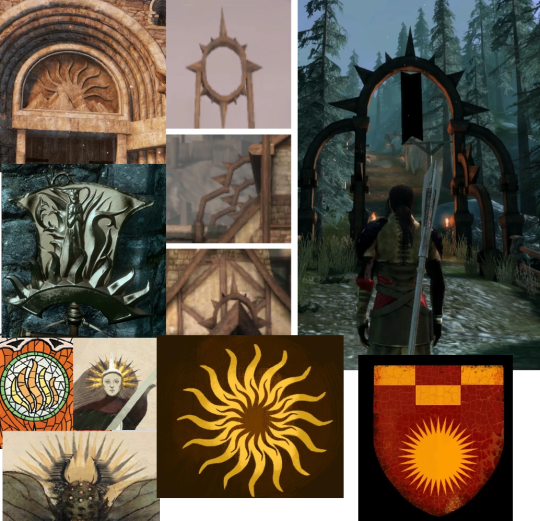
The most typical one that appears in DA series is the Sun or Sunburst with wavy rays, repeated so much along the games that we can identify it immediately. It’s the unequivocally symbol of the Chantry. We found it in many versions, and it represents the “dawn” with the idea of hope and “new beginnings”, but also the fire that “purified” Andraste in her pyre to let her ascend to the Maker’s side. In the posts of Andrastian Art [Andrastian Design: Stained Glasses], we also find that “balls of fire” [which can be interpreted as a Sun in another way] are shown to represent the Maker or the Faith in Him.
Andraste’s single spiked helm seems to be inspired in a single sun ray, at least this is what an illustration in the Chant of Light [book of World Of Thedas] seems to suggest.
In general, most of the representations of the Chantry Sun have 16 rays.
The same sun-like symbol appears in its Tevinter version when we see the Imperial Chantry; the only difference with the Orlesian one is that the Tevinter Sunburst has straight rays.
As a detail, in DAO, we had the typical representation of the wavy sunburst present in some strange devices of Tevinter origin, for example, the ones we found in [Brecilian ruins], while the main Church in Denerim, or in Haven, display spikes that, more than resembling a sun, look like thorns or even a thorny vine. This may be a consequence of an original plan in linking, design-wise, the chantry symbology with the thorny vines that represent the Blight or the Darkspawn [As we explained in the section “Non-mural symbol: Thorny vines” from Murals in DAI: Basics], or merely it was a limitation of the design of the game, as we know DAO suffers from.
We also know that tranquils should display this symbol on their foreheads, burnt with lyrium, but as we saw along DAO, none of them had it. Later we were informed that the devs had problems to add this mark on the npc, therefore, it was never shown until DA2. When it comes to this symbol, it is interesting to see that tranquils carry the metaphor of “a Sun burning their minds and emptying them”, which may or may not be related with Dwarves and their fear to the Sun and potential relatinship of Elgar'nar shoving a fire ball into their underground lands [More details of this concept in Deep Roads [DLC Trespasser]: Lower Walkways in particular with the codex Torn Notebook in the Deep Roads,].
[Strong] Elvhenan Culture: Sun symbol among the Evanuris
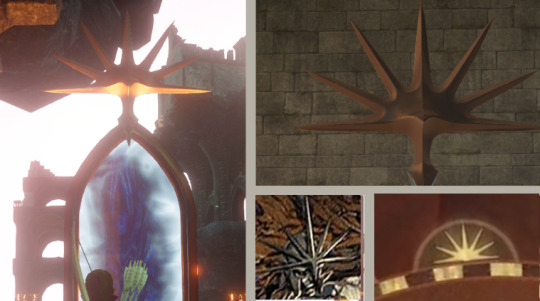
Strangely close to the Chantry Sunburst symbol, we find the “half” sun symbol [tagged along the blog as Sun-head creature] in what we suspect was one of the ancient primordial dragon symbols that some Evanuris took over when they claimed Divinity [for more context, read Attempt to rebuild Ancient Elvhenan History]. It’s hard to say which Evanuris took control of this symbol, but we know there is a clearly sun-like symbol present in the Crossroads of the DLC [as a statue, check The Crossroads [DLC Trespasser]: Entrance] and in the Shattered Library [as an Eluvian, check Shattered Library; Entrance and Courtyard]. With the release of the Vinyl, we also discovered and reinforced the hypothesis that this symbol belongs to or was co-opted by an Evanuris [read Speculations about the Vinyl Art for details] thanks to the image of an elf wearing a hat with that shape.
A consistent detail of this image is that it’s a half-sun with exactly 7 rays.
[Weak] Elvhenan Culture: Asterisk Symbol and Elvhenan Doors
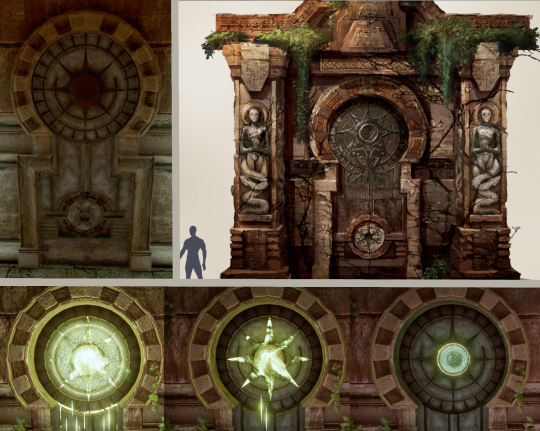
If we extend this imagery, and check other symbols that may look similar to a sun, we find the ancient Elvhenan Doors [Elven Ancient Shard-based door], which top displays a pointy sun of 8 rays that may or may not be related to the Asterisk symbols [also related to the Titan’s core, which I talked about in the post of Murals “The Death of a Titan”]. In the way the door gets illuminated when activated also makes us see a “circle” in it that can be loosely related to the “Golden Ring shape”. More details about this ring will be treated below.
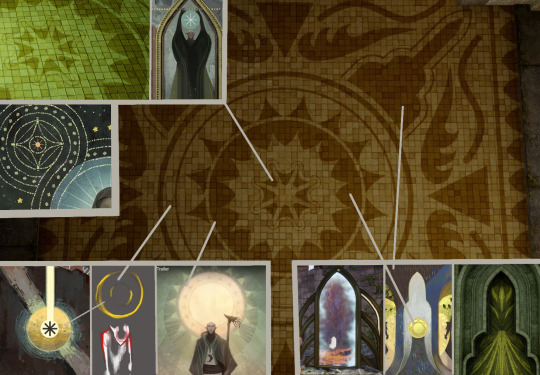
This strange sun on the ancient door also makes us think in the Asterisk Symbol [made of 8 points], which lays at the centre of the yellow mosaic, which may be related to the core of a Titan [asterisk of 8 points too]. The link is immediate when we see that this asterisk is outlined by a shape that looks like a star or a Sun, inside a big ball with triangular-shape ends. This same symbol appears in the last Trailer of DA4, behind Solas, when he is presented like an Hermit, mysterious, apostate mage. Around this “sun” we can make out several concentric lines that may refer to a “Golden Ring”.
The Asterik symbol also appears in murals such as “The Creation of the Veil” or “The Death of a Titan”, which allowed us to relate them with the core of a Titan and its immense power of "making real what you imagine"reinforcing the reality", but this symbol also appears in a corner of Solas’ tarot card.
The yellow mosaic also has some shapes at the four corners that may represent eluvians or something related to Mythal. In the mural of “the Temple of Mythal” from “The actions of the Inquisitor”, we see that Solas draw a particular star of 8 points inside a door frame that resembles this “eluvian outline”, but it’s also the shape of the doors of the Temple of Mythal which represents Mythal herself in her dragon shape. All these symbols seem to reinforce the idea we explored in “The Death of a Titan”: Mythal seems to be related to the core power of a Titan represented by an asterisk that evolves into a golden ring and into a sun.
As I repeated several times in Speculations about the Vinyl Art, at times, we find some hints where stars or balls of fires [also understood as suns] are related to Mythal and Elgar’nan, making us suspect that, maybe, Mythal and Elgar’nan share a nature similar to Falon’Din and Dirthamen’s: apparently, the same creature with two different aspects from them. If this were the case, associating Mythal with the Sun would make sense, and it would also explain why, if Elgar’nan was so central in the Elvhenan culture, there are so few representations and statues of him, while Mythal overwhelms it.
[Weak] Elvhenan Culture: Golden Ring
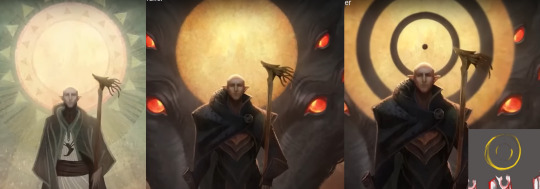
During the last trailer of DA4, we see Solas turns into the Black Dread Wolf as a sun in the background becomes a moon [single golden circle] and later, it separates itself into concentric rings, that may or may not be related to the “Golden Ring” so deeply entangled with Elvhenan culture. Thanks to this imagery, we may relate the Sun to the Golden Ring [specially if we consider that the mural presented in Nation Art: Elvhen displays the yellow ring in a position that may be considered “the sun”, but also the "authority/power above"]
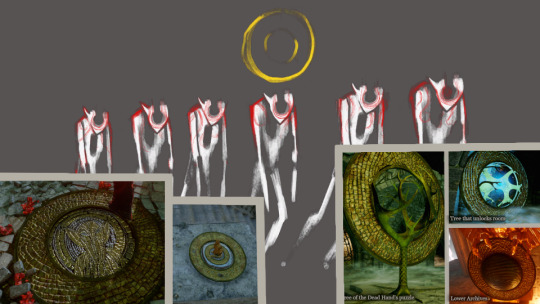
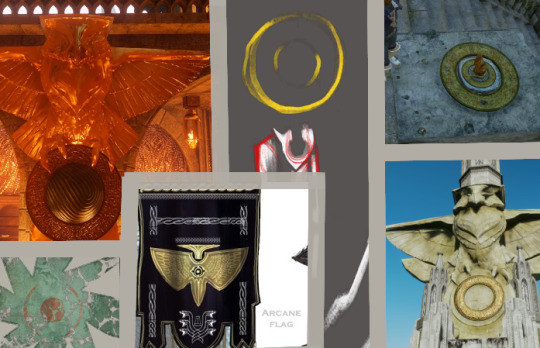
We need to remember that the Golden Ring’s presence is always associated with control, power, and occasionally to Mythal and Dirthamen. In the mural of the “zombie elves”, it’s above all of them, and due to this position, it could be interpreted like a “sun” or moon upon the controlled, zombified elves. But I’m not too convinced in this interpretation, since we already explored in posts such as: Nation Art: Elvhen, Exalted Plains: Ghilan’nain’s Grove and the Dead Hand, DLC: Jaws of Hakkon - Frostback Basin, Elvhen Tomb, Ancient Elven codices; Fen’Harel’s mountain ruins, The Crossroads [DLC Trespasser]: Elven Mountain Ruins; Vine-covered Tower, Murals in DAI: The Death of a Titan, and Speculations about the Vinyl Art that this ring was more related to control, power, or even forced change/shape in some cases. Due to its power or potential knowledge, it's also associated to Dirthamen Owl [which also could be Andruil's owl according some inconsistencies in the same Unreliable Dalish legends].
On the other hand, it’s never clear if this symbol may have morphed into a sun along the ages with the loss of memory that the Elves had throughout generations when they lost their immortality. However, I tend to consider that this Golden Ring may have changed into a Sun when it entered in contact with human groups, in the same way that I see the story of Fen'Harel gave enough context for humans to create the Maker myth based on him, potentially during the time of Halamshiral [for more details, read The Chantry and the Mythology of the Chant of Light]
This ring also appears in the last scene of DAI, when we defeat Corypheus, showing Mythal inside it, as bits of red lyrium sprout around it. This can be related to many speculations done in Speculations about the Vinyl Art, where we can conclude that another fragment/part of Mythal is still trapped in the Black City, corrupted, and contained by an immense power that may have been used before by the rest of the evanuris to control their own people.
The Golden Ring has also been seen enclosing Elven Tree Statues and Elven Orbs, implying its relationship with elvhenan power and/or Mythal’s [after all, we know that Mythal took the power from a Titan from which elvhen orbs were developed, and trees are also her symbol, according her vallaslin]. It's worth noting that the only working orb we saw in the game was Mythal’s, so far.
[Weak] Elvhenan Culture: Crappy Sun
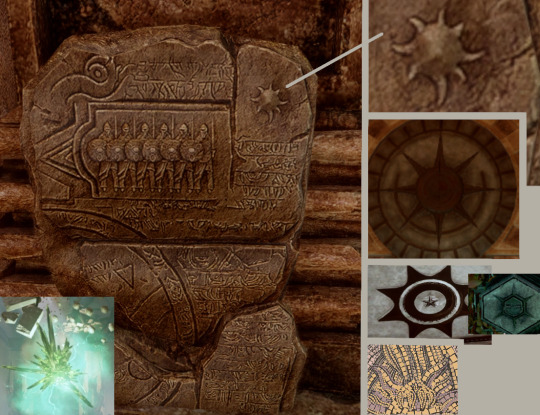
There is also a strange symbol that I called “crappy sun” in the ancient tablet we find at the entrance and deep into the tomb of Forbidden Oasis: Solasan Temple [along this blog I’ve tagged it as “Stone in Razikale-Ceremony-style”]. It’s hard to say if it represents a sun or a breach. It may be related to a sun similar to the one of the Elven Ancient Shard-based door that, later, Tevinter co-opted to turn into the several versions of pointy suns we see in Tevinter Pre-blight ruins, [let’s remember they were not Andrastian yet, and still they had this symbology in their buildings and elements because it may have been related to ancient dragons, or taken from another elvhen symbology during the time of the Dreamers since there are some proofs, such as the Tevinter Mosaic [Invasion], that may show that Tevinter had a better relationship with elves back then].
Maybe the original symbol was related to Elgar’nan, as we see in his mosaic, where he shoves down the sun into the earth, and its rays are wavy and a bit “crappy”. If this relationship is correct, maybe what Elgar'nan shoved into the Earth to destroy the dwarves/Titans was not a sun but a breach? Again, a very unlikely hypothesis.
This “crappy sun” also has 8 rays.
[Strong] Elvhenan Culture: Elgar’nan and Sylaise
Elgar’nan’s mosaic was interpreted in the post Evanuris, and basically shows an elf shoving down a Sun of wavy rays into the Earth. It’s easy for us to relate this image to the unreliable Dalish legend of Elgar’nan [read Elgar'nan: God of Vengeance]. Elgar’nan is presented here as the son of the Sun itself, who tried to burn all life on the Land out of Jealousy, so Elgar’nan vowed vengeance against his Father’s cruelty, and his rage won against the fire of the Sun. Then, “Elgar'nan threw the sun down from the sky and buried him in a deep abyss created by the land's sorrow.”
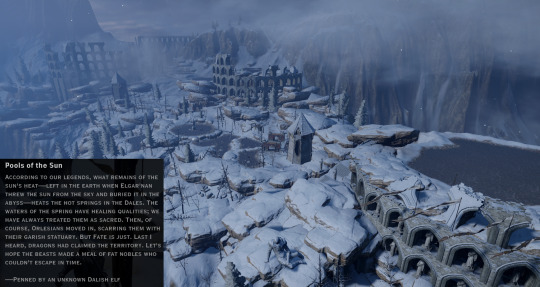
This story can be followed later in the post Emprise du Lion: Pools of the Sun, where we find another unreliable Dalish legend claiming that this place has spring waters because it was here where Elgar’nan shoved the sun into the Earth. I also made a link to Sylaise considering the Elvhenan arenas we can see in this region, the presence of Sylaise’s Shrine, and her thirst for being always competing with someone. These details can make us suspect that this Sun could have been Sylaise [so deeply related to fire, the sun, and also as angry as Elgar’nan according the Song to Sylaise].
It’s very worth noting that these two legends, said by different clans, claim that Elgar’nan pushed the Sun into the Abyss. Another detail we have to assume is that "Abyss", "Beyond the Deep Roads" and "The Void" seem to be one thing related to the places where the Titan sleep [or even inside the Titan themselves] instead of a strange dimensional pocket we never saw before. This links the Elvhenan with the Dwarven in what we speculated in Murals in DAI: The Death of a Titan.
With this relationship, we see again the Sun as a weapon of destruction and control.
[Weak] Elvhenan Culture: Murals

Murals present a red sphere with rays that may imply a Sun .
In the mural “The Creation of the Veil” [1], we find a red sphere inside a black one, making us suspect it’s the big evil released by the Evanuris that Solas isolated with the creation of the Veil. Around it, there are seven “bubbles” with similar “rays” in grey and golden colours that may imply “gates” that would allow us the access to the central “sun” or red sphere.
In the mural “The Death of a Titan” [2] we talked extensively about the asterisk symbol, its representation of a Titan’s heart and all that power associated with it, as well as with Golden Rings. The codex in here speaks of a red sphere that contains fury, and maybe all of this can be related to a sun, or better said, the other way around: a Sun as a sphere of fire, related to fury, and buried below underground to contain its destruction. This also brings us some similarities with the unreliable Dalish legends about Elgar'nan.
In the mural “Red Lyrium Idol” [3] we also commented how the image looks as if Solas were walking on a sphere of fire. It may be related to the red lyrium idol too. Here, we keep linking this idea of a “sphere of fire” as a potential Sun.
In the murals of “The actions of the Inquisitor” [4], we see several times that the red sphere associated with the big evil isolated behind the thick, impenetrable barrier of the Black City seems to be positioned in places that may allow a soft interpretation as a “sun”in the sky.
These symbols seem to gather more importance as we analysed the Vinyl Art, where we find the concept of the Eclipse [as an ominous symbol of Fen’Harel that covers and hides the Sun] and a lot of iconography of stars, which can be interpreted as “suns”.
[Weak] Tevinter Culture: Green Star

Pre-Blight Tevinter art has a “star” symbol that may be interpreted as a sun, specially if we consider that the inside of this green star displays the symbol of the elvhenan Golden Ring in red colour. However, it seems more likely to be a symbol representing the power that one can extract from the Breaches. The green colour helps in this interpretation and puts it a bit farther away from a sun interpretation than other symbols. However, it keeps linking the Golden Ring with the power of creating a Breach.
[Confusing] Tevinter Culture: different decorative elements
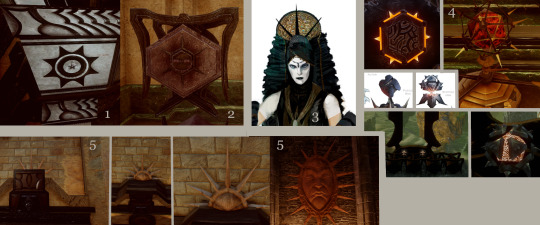
The rest of the symbols in Tevinter objects may have some relationship with the Sun. For example, we find doors, boxes, and columns decorated with an 8-pointed star [1] but we also find another one with 6 points in something that looks like a box [2]. The shape of an “hexagonal” sun of 8-pointy rays can be found as well in objects like the “scrying orb” [4].
Among the outfits, we find a 3-ray comb used by Tevinter women [3], which may be related to the sun-based symbol of an Old God [and potentially related to the corresponding Evanuris associated with it]. This symbol is a lot closer to the "Sun-head creature" we found among Elvhenan objects.
As a curious one, I will always point out the strange, hidden Sun figure that belongs to the Free Marches decoration that can be found at the entrance of the Inner Sanctum in Western Approach: The Still Ruins, Viridis Walk and Inner Sanctum.
I think it’s clear and safe to say that most of the sun-based symbols present in Tevinter culture [and previous to their conversion to Andrastian religion] may have been originated from the contact with the Elvhenan [during the Dreamer time where we can see less repulsion to Elvhen according the Tevinter Mosaics] or [most likely] with the dragons that may have been related to the Elvhenan, as I made the connection in the comic post The Missing.
[Weak] Dwarven Culture: Fairel and Dwarven art
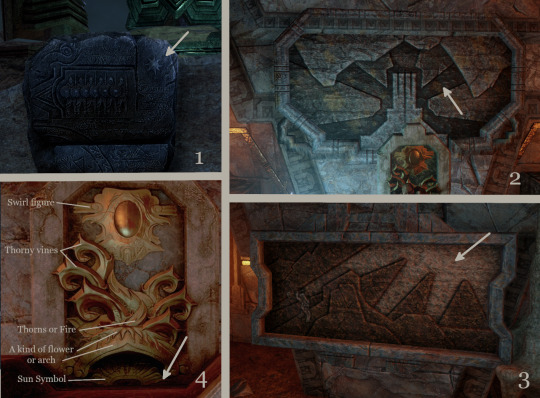
The Dwarves, at least the ones in the Fairel’s ruins, may have some link with the Sun as well. In these ruins we find the same exact stone tablet we find in the Ancient Elvhenan tombs [1], which displays the “crappy sun” I commented above. Once again, it could be a sun but also a breach, so there is no much sense to keep focusing on it.
Another symbol to relate the Sun to the Dwarves may or may not be an old “Dwarven stone-paintings” we saw since DAO, which basically shows a dwarf working the stone [3]. Based on symmetry, we could assume that the triangles on the background are stalagmites, but if we stretch-out this interpretation, they could even be seen as a sun with its rays. It’s very unlikely, since it seems to be more a design resource to highlight the scene of the stone-painting, but for completion’s sake I think it’s worthy to keep it commented here.
However, this simple design allows us to interpret it in different ways: the spikes we see can be pieces of rock protruding from the ground and the Dwarf in it is mining them [as its original codex in DAO seems to imply], but also it could be understood as a quarter of a Sun peeking through the corner of the image as a Dwarf works tirelessly.
Later in DAI we are introduced to another piece of art of similar characteristics [2]. The building was never possible to be identified unequivocally, and in posts like “Architecture of Kirkwall : Gallows and Lowtown/Darktown” I related it to representations of Kirkwall or cities that may be similar to Kirkwall where the runecraft mastery of dwarves was used [and probably, it was a source of pride for these clans, who may have kept the achievement immortalised in a piece of art reproduced among the noble dwarven families]. This piece also shows a background very similar to the one in [3] that may be a representation of stalagmites or a sun, if it’s stretched-out enough.
Another strange symbol in the dwarven furniture is the one presented in some stone-seats: an elaborated metal image that shows thorny vines on or over a sun [4]. This symbol appears in many other parts of the game where there are dwarven rooms, but also in Arbor Wilds :Cradle of Sulevin where we can read the Vir Tanadhal, However, in this case, the symbol is not completely the same one than in the Hissing Wastes: Fairel tomb.
It’s hard to suspect if this is a mere reuse of assets, it has a lore-related meaning, or it’s just a reflection that the Dwarves and the Ancient Elvhen had a relationship quite ancient [as it shows the Elvhen tree and its dwarven, more geometrical style, that I’ve been pointing out since DAO in Orzammar]. We have to remember that the Ancient Elvhenan saw the dwarves as soulless creatures, workers of the “pillars of Earth” and worthless. However, I always claimed it was never clear if this was a reference to ancient Dwarves that were linked to the Titan deeply to the point that they became Sha-Brytol after the break of the link, or were related to more independent dwarves as the ones we see now, who have a sense of Stone, but can’t understand the Titan with the exception of some gifted ones [such as Valta].
Finally, the dwarves have an additional aspect related to the Sun in the very unreliable codex called Torn Notebook in the Deep Roads, Section 2. I wrote about this codex in a more integral way in Deep Roads [DLC Trespasser]: Lower Walkways. But basically an ex-Dalish elf [now a Qun converted] relates Elgar’nan’s fire [which another unreliable Dalish legend, Elgar'nan: God of Vengeance, claims he shoved the Sun into the Earth] to the fear to the Sun that Dwarves experience [Read the section Elgar’nan and Sylaise above]. This may have been a Dev’s choice to makes us aware that there exists a relationship between the Sun and the dwarves, even though there is no lore material that can make it clear enough.
[Strong] Ferelden Culture: The Sun Face and the geometrical Sun

In the Tryptich presented in Andrastian Design: Tapestry and Tryptich, we find three symbols on top of each part of the scene: the six-snakes that represent Tevinter, the golden city above all the image representing the Maker or the Chantry Religion, and over the section of Ferelden/Orlais chantry, a 8-pointed sun which rays look like triangles. Once again, the resemblance of this symbol with the elvhenan sun in the mural “Temple of Mythal” is remarkable [check the Temple of Mythal in “The actions of the Inquisitor”] or the sun shape in the elvhenan yellow mosaic or in the background of Solas in the Trailer of DA:D. This could come from different roots:
1- An Orlesian root, considering how much of the elvhenan influence it had during the time of the Halamshiral and the coexistence of humans and elves in the Dales for some years [to the point where inter-racial families were made, as it was hinted all over the Exalted Plains]. I spoeculated how the idea of the Maker may have been developed during this time in the post The Chantry and the Mythology of the Chant of Light
2- Another potential root is related to the Alamarri root, and therefore, linked to the Avvar: this sun may be a representation of the Lady of the Sky for the same reasons I will explain below in the Section Avvars and the Sun.
We can find similar icon in the book World of Thedas, where they show a unique Ferelden Tryptich [3], which top displays this symbol with a sun that even may have a shape of a Golden Ring within it. In either case, we know that this symbol later was part of the Ferelden Chantry, which sun is very pointy, as DAO showed it [see the first section in this post: Chantry Sunburst].
In DAI, we find in some small towns of Ferelden, a unique strange Sun with a crying face [1]. On it we see a bird and a squirrel. It’s hard to know exactly what this is, [check the post Nation Art: Ferelden], but maybe it can be understood as a representation of Andraste made by Ferelden culture mixed with some local animals and fables created as a mixture of cultures, similar to the tale that related Wyverns to Andraste [check the wyvern section in Dragon Age Iconic Patterns: The single spike].
There is also a fish drawn in the DLC of Hakkon on a fisherman shack [2], which displays a pattern that can be related to the “crappy sun” designs on its skin. Not sure what to make about it. The closest is that the Avvar represented this symbol as a way to reflect what they may have seen in the Isle of the Lady, where a big ancient breach have been there, open, since the time of Telana [read about this in “The Veil and the preservation of the Waking World” from the post Frostback Basin [DLC]: Miscellaneous ].
[Strong] Grey Wardens and the Sun

The typical symbol of the Grey Wardens involves a chalice that represents the Joining ritual. It always displays a Sun, and not any sun: it’s one with a strong resemblance to the Sunburst of the Chantry. Let’s remember that the Grey Wardens was and is an independent Order that doesn’t respond to the Chantry, and even more so: it was created before the existence of the Chantry, and before Andraste was born. So any quick explanation that this sun is present in this object due to some potential influence from the Chantry seem unlikely.
However, as I showed in Western Approach: The Still Ruins, Main Chamber and Hall of Silence, there are griffons with this same chalice that belonged to pre-Blight Tevinter, maybe remotely associated with Dumat in some ways [since they appear in a hall called “Hall of Silence”, and Dumat=Silence]. We know that the Joining, as a ritual of blood magic, came from the knowledge of Arlathan elves and Tevinter Mages during the desperate times of the First Blight when nothing seemed to stop the darkspawn and even slaying Dumat did not work the first time. Therefore, this Sun may have some relationship with the elvhenan, the Old Gods, or just the blood magic that allowed the creation of the Joining.
[Curious] Avvar and the Sun
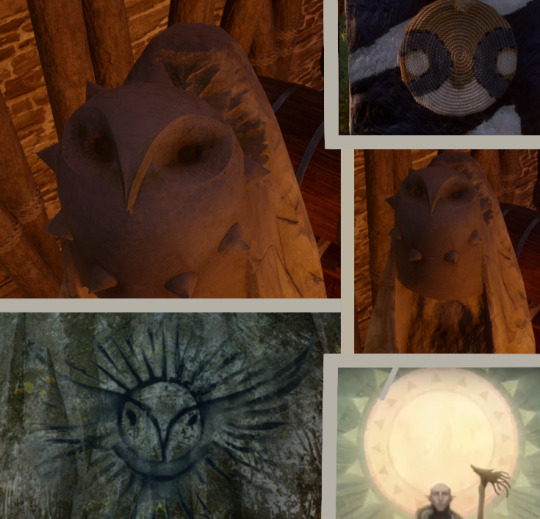
The Avvar have a symbol that I always found very Sun-like due to its design and cultural concept: The Lady of the Sky. It’s not only the concept; the lady of the sky can be any important object in the sky; moons or suns. Since Thedas has two moons, it seems more plausible to think of her as unique as the Sun itself.
In the painting that represents her (found on a wall in the Frostback Mountains) we see a design of an owl which shape looks like a Sun. Even her sculpture in Skyhold displays small spikes around her neck which give her a low-key “sun-like” design, specially if we relate this shape with the “sun” shape we saw in the Ancient Elvhenan Yellow Mosaic or with the star we saw in the “Temple of Mythal” mural [in “The actions of the Inquisitor”] or with the Sun that appears behind Solas in the trailer.
Curiously, her banner displays her eyes in a shape that looks similar to the Golden Ring shape, but in black colour. That the Avvar have an art that may have resemblance with Elvhenan's is not strange for me if we remember that Tyrdda Bright-Axe Path’s story narrates that her lover was an elf that, as it is hinted, may have been the Lady of the Sky herself. This means that the Avvar always were a culture under the influence of the Elvhenan and the Dwarves [due to the marriages they arranged with the children of the Stone].
[Weak] Flemeth
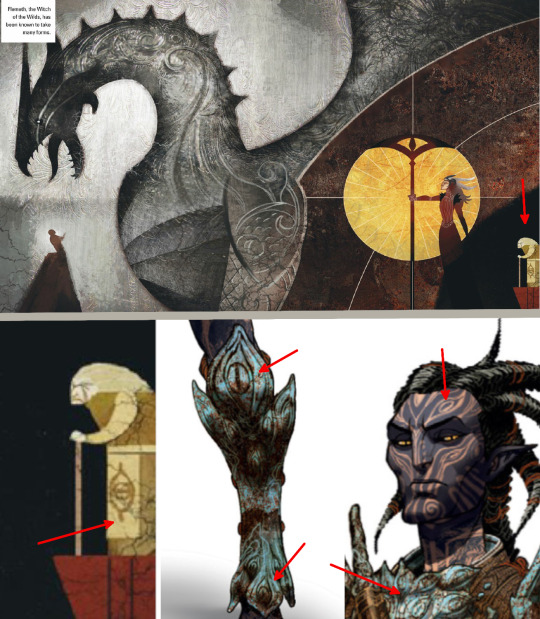
Flemeth also had a unique concept art that shows all of her nature in one drawing: her dragon shape, Mythal, as the central part of it over a human figure that may be a petitioner; a bit aside and as if she were in a inner ring of a brown sphere, The Witch of the Wild: Flemeth, with a very particular staff inside a yellow circle that may be interpreted as a Sun. And very hidden in the corner, in the core of this sphere, now black, we see her as an "old, old woman" with a big eye drawn on her apron, at the edge of a cliff [potentially representing the fragment of Mythal that lives inside her]. This kind of eye is very similar to the ones that we see in the concept art armours of Mythal’s temple guardians. I assume it has to do with her omnipresence due to the manipulation of dreams [we know that she presented herself in dreams to an elf and marked him with the Vallaslin of Mythal after awakening, check the video]
Mythal also has bland hints related to Elgar’nan symbology, which is related to the sun, fire, and balls of fire with anger [check all this in the posts Speculations about the Vinyl Art and “The Death of a Titan”]. Flemeth ends up being related to all this since she carries a fragment of Mythal in her.
[Strong] Qunari, Par Vollen, and the Solium Constellation
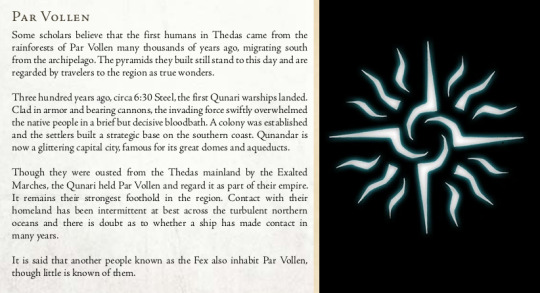
The Qunari have little link with the Sun, but not the land they conquered. In the book World of Thedas we are informed about the existence of the Fex, a race we never saw nor had much information beyond the fact that they exist. May they be related to the Sun or a Sun-base proto religion? We don't know.
In the Codex Constellation: Solium, we learn that this constellation [which looks like a Sun/Star, image above, pretty similar to the Chantry Sunburst I may add] may have been a representation of the Sun or the Moon [or both] for the Neomerian [Ancient Tevinters], however, it could also represent Elgar’nan, since unreliable Dalish legends claim him to be the “eldest of the Sun”.
Another Codex, called The Pyramids of Par Vollen, tells us that the Jungles of this continent have ancient ruins that doesn’t seem to be tombs but places of scientific purposes. The shape of these ruins fits perfectly with the constellation of Solium, making them, in some way or another, related to the Sun. These pyramids are a great mystery in the DA lore, especially for their total lack of information beyond this codex. We know their walls show images of “intricate sea creatures, shipwrights, musicians, archers, and kings. Odd figures are depicted, tall, horned, always in a position of authority and respect.” It seems that there was no resistance when the Qunari came to conquer this place, so we can suspect that this previous civilization embraced the Qun without much resistance, in part, because the Qunari have horns, and that caused respect and authority. Or the civilisation had been gone long ago when they came. Or it was a civilisation that was developed by or under the authority of the Kossith, the ancient Qunari who had no Qun.
The brief description of these ruins also makes me link it, potentially, with the underground ruins we find in The Horror of Hormak .
[Confusing] DAO design
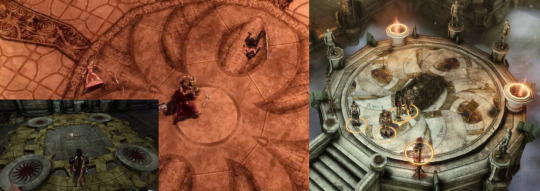
This section tries to relate the Sun shape with designs that may make the connection a bit stretched or not truly reasonable, therefore, DAO leads this part, lol.
We find that many places along the game, specially the ones related to puzzles [Honnleath and Enchanter Wilhelm’s basement] or to Tevinter experiments [Ruins of Brecilian Forest] display a platform on the ground with a symbol similar to the Sunburst of the Chantry. I’m not sure why they are there, specially in the Brecilian Forest, since we know this was a fortress probably developed by Tevinter [ which potentially may have co-opted, as usual, an ancient Elvhenan building and claimed it as its own] just to be taken by Dalish and humans later. This Fortress is a mess in terms of design and statues that it displays, so it’s hard, if not impossible, to truly take it seriously. To me it all feels more like a reuse of graphical resources, but just for the sake of completion, I add the present section.
More of these sun-like platforms can be found in the Tower of the Circle of Magi [which could potentially make sense since the tower was made by Avvar and Dwarves, and it may be a representation of the Lady of the Sky, as we saw in the Avvar section of this post] but also in the Temple of Andraste or in Denerim at the Fort Drakon which makes less sense [unless it is taken as a symbol from the Chantry itself]. Again, these inconsistencies make me suspect the reuse of assets in a game that could not afford to have 5 different platforms designs.
[Confusing] Free Marches Rural Areas
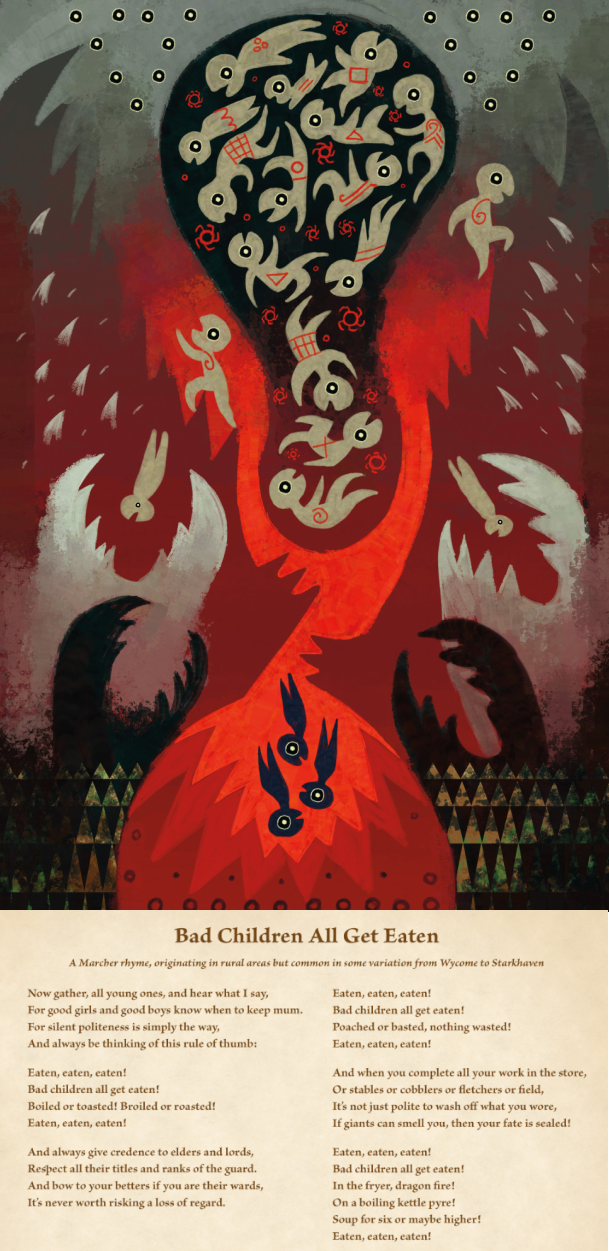
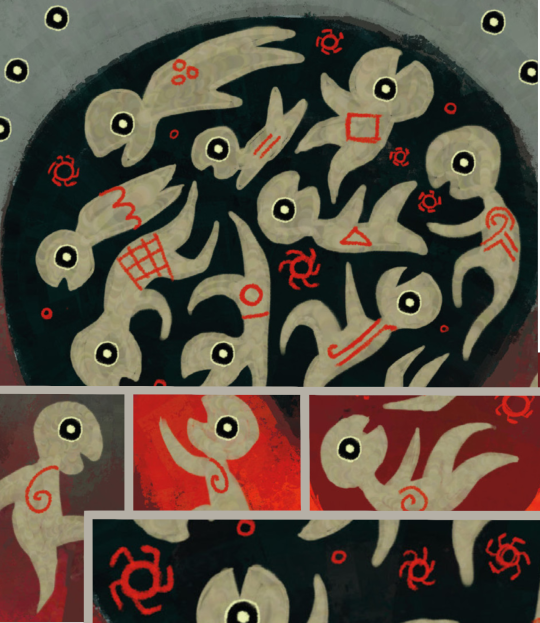
Another place where I found a sun-like symbol was in a very disturbing image of the book World of Thedas associated with a cautionary tale told to Free Marches kids. In it, we see that people/children are punished if they go outside a bubble of darkness with small “sun-like” symbols floating around. Each of these kids have a symbol on their belly or head. Curiously, one of these symbols is a small spiral that I’ve brought the attention upon long ago in the post Hinterlands: Statues, paintings, and structures found in the open where we found the alamarri statue I called Eroded dragon skull which has a “G symbol” on its back, which, at the same time, seems similar to the one present in a reiterative way all over the elvhen artefacts and in some dwarven rug designs.
I don't know how to interpret this image, mostly like the big black bubble that contains these klids seems to protect or shield them from the dangers outside. The kids that "behave badly" are dropped outside of it and are consumed by the dragon fire/jaws of the dangers outside. So in a very stretched way, we can interpret this image that the bubble filled with Suns protects people, or at least, it's the right path to follow not to be eaten by those monsters outside.
Conclusions
To put an end to this post, I would like to bring a short conclusion that we may have reached together along it. The Sun in Thedas is an ancient symbol that mostly every culture took to exploit and use in their own representation of gods/power.
This fact alone is not strange, since in anthropology we can see that severals cultures on Earth have developed religious rites or created Gods out of the Sun itself. The Sun is a symbol related to warmth, light, food, life, and security, so it seems reasonable for DA Lore to take it as the main symbol of Thedas civilisations.
The Sun in current Thedas is immediately associated with the Chantry and Andraste: it is a symbol of hope, of dawn, that provide the idea of new beginnings; it’s also the idea of the Maker itself and the Faith people have in him. It's also the fire that purifies in order to grant ascension [Andraste's case].
When it comes to Elvhenan, the Sun is immediately related to Elgar’nan, who was considered, according to the underaliable Dalish legends, the son of the Sun itself, who in order to save the Land shoved the sun into the ground, potentially causing a great damage to Dwarves and Titans.
There is also a symbol of a half-sun in an Eluvian, a statue, and in a hat worn by an elf, that may suggest that an original god, represented by the sun [potentially an ancient Dragon] was worshipped by the Evanuris. Lately, that symbol may have been co-opted by one of the Evanuris when they took divinity and the identity of the ancient gods they worshiped.
Elvhenan also seem to take the symbol of the asterisk as an oversimplification of the Sun, which across the murals, is also related to the heart of Titans, to power, and to the Golden Ring, which is also associated with control. So, for Elvhenan, we may suggest that the Sun represents immense power, if not, Divinity itself, that may end up being related to the core of Titans. The asterisk is also associated to the orb, a big power object.
Since Elvhenan were the first civilisation we know that started in Thedas [besides the Titans and their children], their symbols of power [asterisk, orb, golden ring] may have evolved along time to reach human groups which developed, later, all the sun symbols that ended up in the Chantry’s.
Thanks to Tevinter, we also can suspect that the Sun may have been a representation of an Old God, since they have a lot of sun-related images in their decoration and objects that belong to ancient times in which they were not Andrastian yet [in fact, so ancient times that Andraste herself was not born yet]. This may mean that the Sun symbol cloud have been taken from the Elvhenan or from the Ancient Dragons. Through Tevinter style, we also realise that the Elvhenan Golden Ring may have been used to create Breaches, which again shows and seems consistent with the idea of relating it to power and control. The symbol of Sun in Tevinter culture may be related originally with Elvhenan or with Ancient Dragons that Tevinter used to worship.
Dwarves have little representation of the sun for obvious reasons, but due to the unreliable legend of Elgar’nan and the war with the Titans, we may establish a relationship in which the dwarves endured the Sun [or the Elvhenan power] at some point in their story.
Thanks to the Grey Warden we can relate a sun with the idea of ancient Blood magic or ancient Dragon blood knowledge, since the Joining is represented by a chalice with a Sun on it.
The Avvar also have a low-key representation of the Sun in their Lady of the Sky, which may be just consequence of their deep relationship with the Elvhenan culture.
Par Vollen may have more answers about the Sun and ancient times, but the lore of DA world is very scarce on this region of the map of Thedas, so we can only speculate.
#Analysis and speculation of Statues#golden ring#alamarri#avvar#Chantry#Dragons#Elvhenan#Flemeth#Grey Warden#High Speculation#Old Gods#Tevinter#Par Vollen#sunburst#Sun-head creature#evanuris#Elven Ancient Shard-based door#yellow mosaic#mythal#flemeth#Elven Owl statue#Stone in Razikale-Ceremony-style#Sylaise#Elgar'nan#Asterisk Symbol#Free Marches Sun#Dwarven stone-paintings#lady of the sky
82 notes
·
View notes
Text
That line that Corypheus says after being released in the Legacy dlc while he's all confused "Be these some dream I wake from? Am I in dwarven lands? Why seem their roads so empty?" highlights how in his time, the Deep Roads really were the commercial and trade arteries of Thedas, and how they must have been constantly bursting full of people and merchants trading and going from one corner of Thedas to the other.

Tevinter controlled most of Thedas, but below the surface, the dwarven empire was what truly connected it, all the distant Thaigs and cities bringing lyrium and other things all over the continent, and even trading with the Chasind and the Avvar as far south as Ferelden (and according to Bianca, its possible the Deep Roads might have gone beyond Thedas itself)

And then Corypheus wakes up a thousand years later and assumes he's on the Deep Roads and is puzzled as to why it all seems so empty and lifeless. And the irony is that, even though he doesn't know it yet, thats what the Deep Roads and all the dwarven lands except for Orzammar and Kal'Sharok have become. A dead, lifeless carcass filled with darkspawn, with decaying statues, crumbling Thaigs and a few squads of the Legion of the Dead representing the fading memories of the glory of the past that once was and will never be again, and slowly fading into history like the dwarves themselves.
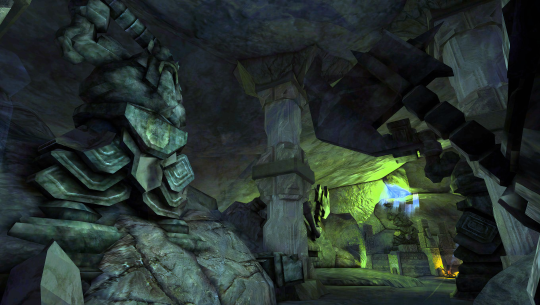

#do you ever think about the dwarves and just cry?#dragon age#dragon age dwarves#dragon age meta#legion of the dead#dragon age lore#corypheus#the deep roads#orzammar#kal'sharok#illusivesoulrambles#thedas#dragon age origins#dragon age 2#dragon age inquisition#tevinter imperium
182 notes
·
View notes
Text
there's something fascinating to me about the fact that mythal's fragmented spirit went on to try and help the world. we don't know how much her spirit was fragmented, or how many pieces there were, but I think this appeals to me because it does connect with lore from the previous games
veilguard all but confirms the popular theory that andraste carried a piece of mythal's spirit. people have been talking about the mythal/flemeth/andraste similarities for years! morrigans cryptic comments seem to tell us that that same fragment later came to flemeth after she was 'betrayed by those sworn to love her', which is I think confirming the version of flemeths backstory that she was married to a poor poet who sold her to a lord, who then killed the husband and imprisoned her.
whatever her faults, flemeth has frequently popped up to help when the world needs it. we know she's spent time with the dalish over however many centuries, since they have their own name for her. even just looking at the previous games - we wouldn't be here without her. the warden? dead. hawke? dead. inky? lasts a little longer maybe, but still dead. I defs wouldn't say she was a 'benign' influence like emmrich says, but if not for her intervention, we simply wouldn't be here.
but there's other stories throughout the history of thedas that have been attributed to mythal.
there's yavana, an antivan witch thought to be a daughter of flemeth, who's protecting high dragons since they'd vanished from the world prior to the start of the dragon age, who is implied to contain a fragment. (this also makes me wonder, if this is a separate fragment of mythal, did flemeth go around finding her fragments and putting them to use? is this a fragment of the fragment flemeth contained? many questions)
there's tyrdda bright-axe, the mother of the avvar, who led her people to fereldan at the advice of her lover, a spirit in the form of an elf, who was said to be the lady of the skies. nice that mythal had a gf for a while, as a treat
in the hissing wastes in dai, we find the remnants of an ancient dwarven thaig built on the surface, the only known of its kind, that pre-dates the first blight. the codex entries imply that when they left because of a civil war between the dwarves, they knew to be wary of dragons, even though they'd never seen one before. there's a statue of mythal watching over the tomb of paragon fairel (the dwarf who led them to safety). did mythal lead these dwarves to the surface in a hope to help them given what was going to happen once the first blight happened? it's not hard to imagine she had regrets over the dwarves and the titans, and that she might've wanted to atone by helping in some way.
flemeth tells us in da2 that 'regret is something I know well'. while we don't know exactly what regrets mythal has, it's clear she has them, and it's easy to see that she might be watching over this world to make up for her part in breaking the one that came before.
is the fragment you meet in the fade a bit of a bitch? sure. I probably would be too if I'd spent hundreds of years unable to do anything but watch the world, when my very nature was to help it, and my only friend had never visited me but instead went on to try and destroy the current world out of a very misguided attempt to make up for our mistakes. and still, even though this is the fragment that's never grown from spending time in the world, she still helps us. of course she does.
however much I'm not really satisfied with the conclusion of her story (I wanted to see that vengeance that would shake the very heavens, I wanted to see her fight with us against elgar'nan, and instead it culminated in her just being used to persuade solas) I do think that the fact that she cares about the current world has always been there in the previous games. it's funny actually, because as much as the writers keep telling us the dalish were wrong about their gods, mythal ended up becoming what they believed of her. protecting the world as best she could.
biggest complaint was she should've been voiced by kate mulgrew tho
#dragon age the veilgaurd spoilers#datv spoilers#mythal#flemeth#datv#dragon age meta#idk what to tag this as really it got soooo long#like i wish we got more with mythal! I wish we actually saw some things from her pov regarding the evanuris#i wish we actually got to learn more of her outside of solas#i wish shed gotten to have agency and fight at the end!!#i wish we'd seen her fight i wish shed gotten her justice that was denyed to her#but the confirmation that shes been trying to help throughout history is based on stuff in all the games#and i do like that
48 notes
·
View notes
Text
Has anyone stopped to think about how, like, Lavellan wouldn't be able to forget about Solas even if she wanted to?
"It's been 8 years since Trespasser. She should have moved on by now." Like, how? If she didn't disband the Inquisition and still leads it, then trying to stop Solas is literally her everyday life.
And maybe she left and rejoined her clan. Can you imagine every day looking at faces with vallaslin and remembering how Solas said the evanuris weren't who the Dalish thought they were? Or performing Dalish customs and wondering if any of it actually connects to Ancient Arlathan? And that, god dammit, Solas would know the answer - and she probably wouldn't like it? How about any exclamations of "By the Dread Wolf!"?"
God forbid your Lavellan travels after the events of DAI because we know those Dread Wolf statues are everywhere. (And that they sit outside Dalish clans).
And maybe, like my Lavellan, she decides not to go home. But she still want to research and learn all she can about the past. Everything she could possibly uncover could link back to him. Certainly anything elven. But even Dwarven ruins aren't safe because we know the elves missed with stuff there. Ancient history isn't safe. Even studying modern cultures - like the Avvar who are so friendly with spirits and thinking about how much Solas would fucking love it!
If Lavellan's a mage and has any discussions on spirits or the Fade - of course she's going to be thinking about what Solas knew.
Maybe she joins the Red Jenny's and tries to heal things one person at a time. How can she not think about how much Solas only ever wanted to help people? But that he's also going to tear down the Veil and kill everyone? Is anything she's doing right now even going to matter in a few years? If only she could show him small incremental change that he could be doing right now instead of total destruction.
How can she not think about him all the fucking time? How does this girl keep from going insane?
Remember, there's a scar in the sky from where they closed the breach. She's going to see that every damn day.
Also her arm is gone from when he took it right before disappearing again, so that's also a constant reminder.
Nowhere is safe for this woman.
She should just escape reality and drift off into Fad-
130 notes
·
View notes
Text
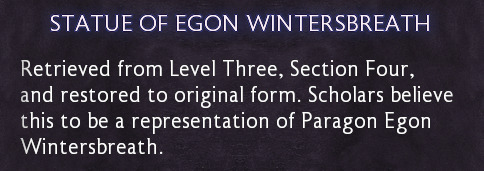
oh i have so many questions about this statue I just found in Kal-Sharok
Like... Wintersbreath. As in, Hakkon Wintersbreath? Born in battle, bloody-bladed? Wintersbreath to wrack the lowlands, cold to cut and kill the hated?????
This might be a bit of a tinfoil hat moment because I don't believe I've heard this before, but... would it really be such a stretch of the imagination to assume that there might be a faint thread of connection between the ancient dwarves (now the dwarves of of Kal-Sharok) and the Avvar through this, the Titans, and the separation of Stone and Skies??? Though the setting is still one ostensibly without real deities, could Korth the Mountain-Father still have something to do with the literal mountains?
(honestly, Hakkon Wintersbreath having been an ancient dwarven warrior/warlord from the time before the dwarves would have fully retreated into the bodies of the titans, and the surface elevating him to godhood over time while the dwarves of Kal-Sharok carried on his name in their family lines and made him a revered ancestor would be so fucking interesting to me. I want to gnaw on this juicy-ass bone until I can slurp out all of its delicious lore-marrow.)
#squirrel plays datv#dragon age#dragon age the veilguard#i need to re-read everything about the avvar and the alamarri and the chasind#and all the scattered human tribes of thedas
20 notes
·
View notes
Text
Dragon Age Theory: The Maker was a Titan? Elgar'nan?
READ WITH CAUTION, THIS CONTAINS SPOILERS FOR EVERY DRAGON AGE MEDIAS UP TO DATE!!
Just some thoughts I wanted to put down:
The Maker is a Titan lying under Orlais?
"Weep not for me, child. Stone they made me and stone I am, eternal and unfeeling. And thus shall I endure 'til the Maker returns to light their fires again." — Eleni Zinovia during the Mage Origin (Dragon Age Origins)
The Chant of Light could be an attempt to re transcribe the Song of the Stone — which actually comes from Titans.
“Blessed are the righteous, the lights in the shadow. In their blood the Maker's will is written. — Benedictions 4:11
There’s this constant mention of voice and songs shaping the world for or by The Maker. It’s a common theme between Elves, Humans and Dwarves:
The Maker created the world with his voice.
Andraste made the Canticle hymns to praise the Maker.
Leliana is nicknamed the Nightingale, a song bird.
Isatunoll = Dwarven (Isana → Lyrium but Isatunoll is, according to Lace Harding:
"Isatunoll is an affirmation. A statement of existence. Of… being. Isatunoll is the eternal hymn that encompasses all time. All spaces. I am. We are. This. And that. Here. There. Now. And forever.”, like a hive mind)
Ir sa tel'nal = Elven (I am empty, full of nothing)
Asala = Qunlat (Soul) Referred to as “The voice of the Maker”, the song of the Lyrium, Titan’s blood.
"It's singing. A they that's an it that's asleep, but still making music.” — Cole, Dragon Age Inquisition
The Golden City is sometimes called the Wellspring of Creation in the Chant of Light. In The Descent DLC, the inner sanctum is also called the Wellspring.
Andraste’s Sacred Ashes temple is underground, maybe where the Maker/Titan rests? For something unravelled for decades/centuries, it’s still in perfect shape. Maybe they weren’t “magical” but the place they remained in made them so? Pure Lyrium mixed to her ashes? That’s why Leliana turns into a Red Lyrium ghost if you defile the Urn and fight her in DAO?
The amount of Dwarven statues in the Hissing Wastes (Orlais) and the rest of Thedas.
“Seven times seventy men of stone immense Rose up from the earth like sleepers waking at the dawn, Crossing the land with strides immeasurable, And in the hollows of their footprints Paradise was stamped, indelible.” — Canticle of Exaltations
The Avvar — one of the Allamari tribes — and Dwarves stories are intertwined, with Tyrdda Bright-Axe, Avvar-Mother
Then did Tyrdda look to Hendir, dwarf-prince friend, children-giver, Took her freedom, Hendir glad, wished her what he could not give her. Chose her child to stand as chieftain, after all last wrongs were righted, Gifted goods of worldly want, left her tribe no more benighted. Skyward, one last trek she made, To her lover, dream-delivered, Raven-feathered, reunited, Hearts both whole, now neither aching. — Codex entry: Saga of Tyrdda Bright-Axe, Avvar-Mother, 8th stanza
Let’s not forget the Inquisition, allied with the Chantry the origin of the Seekers of Truth and Templar Order, believes in the Maker. Yet, their symbol was most likely created based on the Avvar’s symbol Visus, the eye of the Lady of the Skies.
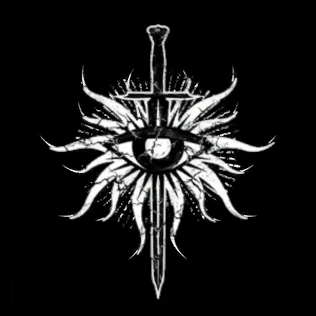
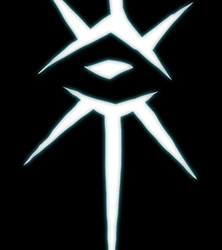
Titans live beneath Orlais.
"The Stone lives beneath Orlais." "Mathas gar na fornen pa tot isatunoll" — The World of Thedas, Leliana’s letter “We Who Did Not Belong”
She translates it to "I regret the sacrifice of my kin, but it means we will find our way home", but now we know isatunoll doesn’t truly mean “home”.
The Occularum are made from Tranquil skulls. They’re reveal the location of hidden magical shards in Inquisition, and these are nicknamed the “Elfstones” by Avvar.
Tranquils got their connection to the Fade completely cut off, the same way the dagger severed the dreams of the Titans.
As far as I’m aware, only the Chantry performs Rites of Tranquility. Which is why I’m mentioning this here to support the links between the Maker and the Titans.
Random additional thought: what if the Void was the Maker’s titan heart? His got broken by Andraste’s murder in the Canticle, maybe a little too literally? The Void is the contrary of the Maker’s creation, right? An empty abyss where even spirits cannot dwell… Where Lyrium, magic and souls are gone :’)
My other theory is that The Maker was indeed Elgar’nan:
In Veilguard, upon fighting him, he says he’s the creator:
“Such arrogance, thinking you can hide from your creator. And I am this world’s creator.” In French, we call the Maker “the Creator”, so he uses the same exact words.
The Chantry symbol is a Sun, with a tinier “sun” making it hollow. Kinda like the eclipse, it could symbolize the moon and the Sun overlapping.


The Golden City was released to be Elven in Veilguard. The place supposed to be crafted by the Maker, his throne.
What does it mean for Mythal?
Andraste might be one of the first person who carried Mythal’s fragment.
Morrigan said her fragment of Mythal "fell in love with an alamarri leader" and I assume that's Maferath?
It wasn't the Mythal Solas knew back in the Elvhen days though, but a human carrying a fragment of Mythal, the same as Flemeth did ages later.
It also works for Conobar & Flemeth, since the story seems to be repeating through the ages.
Final thoughts:
The deities in Thedas are all inspired by each other, tales long lost and modified to fit a narrative. It’s not surprising to want to compare and figure out the truth behind all the lies and half-truths we find in those games. In the end, I think the Maker, as we imagine Him, was probably extremely different from how the Chantry pictures Him.
He might as well be the entire World of Thedas itself, the first Soul, a Spirit, something alive or dead. Who knows. It’s just interesting to think about all the cultures of Thedas, stealing things from each other across the Ages, slowly forgetting the true with their traditions, rewriting, censoring and modifications.
The Chantry edited and removed Canticles.
The Qun forgot most of its history on tablets only Adaari can read.
The Dalish forgot the origin of most of their traditions.
The Dwarves and their Shaperate edit and destroy ancient records that doesn’t fit what they like.
There’s no way to know what’s absolutely true. It depends on the point of view, the time, the people. And that’s why I love theorizing about this game so much.
What do yall think?
#dragon age#veilguard spoilers#dragon age theory#the maker#titans#fan theory#chantry#Andraste#dwarves#lyrium
38 notes
·
View notes
Note
my other ted talk is that i think it's a boring decision for solas to have been that personally involved in tranquilizing the titans. like firstly why does a lyrium dagger... do anything to titans. they are already made out of lyrium, why would poking them with a drop of their own blood even hurt them. if they want the dagger to have been infecting them with some sort of lyrium-borne tranquility disease (???) that needs way more explanation bc it doesn't really make sense on its own. nor dies it make sense for it to be disguised as an idol and blighted and then somehow clean again. secondly it's already established that curing tranquility is pretty easy and you just need 1 (one) spirit to fix it. so like what's the problem. that's actually easier to solve than if the titans were just dead or physically fucked up somehow? thirdly it makes the whole world seem too small and beholden to the whims of one guy if solas did all this stuff. i think the other evanuris should get to be more active. andruil is already established to be really into messing with titans and possibly unleashing the blight, and half the evanuris get no lore at all... what's up with june and sylaise especially. they should get to contribute. i think june should have a mandatory towers of hanoi puzzle, as a treat.
and WHERE did flemythal's whole revenge scheme go. i was just waiting for her to have been using solas and everyone else all along to achieve her own goals... she did not forcibly possess generations of swamp witches just to maintain the status quo. where's that old god soul she went to so much effort to get? arguably even dumat's soul from the first blight may have been salvaged and put into andraste? did she have something to do with that? what was that codex entry about andraste maybe using a secret method to prevent her soul from departing when she died? what happened to those hints in dai about the avvar legends tying into the elves and titans? where's the well of souls juice that either morrigan or the inquisitor get dunked into? what was flemythal doing before solas "killed" her in the dai end credits? why did she tell hawke that stuff about leaping into the abyss?
we will simply never know, bc bioware had too many development mishaps and decided to fire half their staff without severance. sad. we need more passion project itchio game dev artist collectives or something, this late capitalist canadian liberal development process is not good for storytelling 😔
these are great questions. i also love how lyrium has no presence in the game outside of the dagger. red lyrium? never heard of it. and how the lyrium dagger was.... you know. cured of the blight. by solas. he cured red lyrium. he cured titans blood of the blight. how? dont worry about it. shouldnt this be extremely relevant to the entire blighted world of thedas? dont worry about it.
44 notes
·
View notes
Text
INQUISITION COMPANION → VEILGUARD COMPANION VERSE:
This will be replacing my original companion verse

9:41 DRAGON: The Inquisition
Gwendolyn Ingellvar a plucky mid twenties historian, a glorified librarian, was tasked with leaving the Necropolis in order to be present for the historic Divine Conclave being held by seated divine, Justinia V. Requested by King Markus Pentaghast, the Mourn Watch was asked to send an envoy, one of their best in order to document the rising tensions in the South and bring them back to the Watch, to keep the North informed, but mainly, himself. Having shown her passion for the conservation and documentation of history, she was selected to make the journey.
One that would go horrifically and fascinatingly wrong.
Gwendolyn never made it to the conclave, which would turn out to be a fateful mercy as it may have been what ultimately, saved her life. Traveling alone for the first time outside of the safety of the Mourn Watch proved to be harrowing. Unlike her home, she understood that mages were kept in rigid circles, abusive and horrible if her opinion was ever sought, her travels meant to be a straight forward path straight to Haven.
She had never anticipated that she would get so frightfully turned around. And when she had attempted to correct her course, the locals had proven to be far less helpful than she'd imagined.
She, with a thick Nevarran accent, her clothing denoting of her ranking (a decision made so that templars would not be quick to intercept someone of dignitary status) but that meant little to the village folk that looked upon this darkly dressed, witch of a woman. She was either turned around or given misleading information. Days off track, it became apparent to her that she may very well not make it to the conclave at all, shaming herself and the Watch for her ineptitude.
And then, she heard word of a plague, of the undead that have overtaken a southern marsh that was overtaken by an aggressive Avvar tribe. Driven by her innate need to help, she found herself traveling to the Fallow Mire when reaching Haven in time became impossible. While she knew she would be reprimanded upon her eventual return, the plight had compelled her forward.
It is here the Inquisitor will find Gwendolyn. She had been the lead that gave Scout Harding the intelligence of the inquisition soldiers' capture when she'd been here to assist with plague research and aiding those afflicted. She also insists on coming along with the search for the wayward apostate, Widris, imploring that she could appeal to her and assist with the safe handling of the demons and spirits she's summoned in the marsh. This in turn, makes Widris an agent for the Inquisition when Gwendolyn communicates with her as a mage herself and it will be safer with the Inquisition.
Through her combat prowess, incredible understanding of the Fade and spirits, and her keen medical training, Gwendolyn proves to be an asset to the Inquisition and she can be recruited.
While at Haven, she will stay with Adan, acting as his assistant until the siege forces them to relocate to Skyhold. It is from there that Adan relinquishes his clinic in favor of Gwendolyn taking over when the stress of the role became too much. Gwendolyn can be found in the infirmary tending to the sick, injured, or dying. Acting as a mortician in the case of death, she attends to funerary arrangements for their dead. Even if Fereldan customs disturbed her.
Gwendolyn is granted permission to remain with the Inquisition under the conditions that she document the entirety of the Inquisition's life span. As she was present for its inception, they requested she remain until it's inevitable disbandment. Gwendolyn will stay with an Inquisitor, regardless of approval level and choices, in the effort of preserving history. However, regardless of the decision at the Exalted Council, Gwendolyn must return to Nevarra and to her post with the Mourn Watch.
9:53 DRAGON: Veilguard
In the years after her two years with the Inquisition, she published her dissertation about the rise and fall of the Southern Inquisition. It was an academic achievement that catapulted her status within the order, rising through the ranks. While she returned to her typical standard work, her battle tested skillset was not something her superiors were willing to ignore. As she's faced countless enemies of all types, she was requested to consult with new initiates that would be tasked with combat and protection. She offered her experience to them, to impart her knowledge so that it might empower them in their most sacred of duties. She felt as thought she had finally hit her stride, she had a purpose that she adored. Friends made, relationships that she holds incredibly dear. Life was good back in Nevarra.
Until the War of the Banners began.
This is where her companion role intersects, leading a pocket of reavers and mages to fend off an attack when they are captured by undead loyal to the long dead king, Tylus Van Markham. It pans out exactly the same way it does in her main verse, right up to the exile.
But she is not left adrift and is scooped up by Varric as a fresh face to help find Solas, but is folded in as an old friend. She follows them across Thedas in their pursuit, splitting her time between aiding Varric and the Inquisitor until the leads on Solas begin to prove fruitful. She arrived in Minrathous, but the team never made it to the rendezvous point. It wasn't until later that she had realized something happened to them.
You can recruit Gwendolyn officially when you unlock the eluvian to return to Minrathous. She will have found the Shadow Dragons and assisted them until Harding is able to send word and come find her with them. She can be recruited at the Shadow Dragons hideout.
I will get into her quests and things of that nature later, I just wanted to get this down so that it makes sense for any Inquisition characters I might get to interact with!
If you made it this far, you are my best friend.
#【 verse: a house of many mansions — (companion) ☦ 】#【 verse description ☦ 】#i adore this so much and it'll be fun to interact with inquisition muses with her in this role ahhh i hope it makes sense
6 notes
·
View notes
Text
Weekly Jungkook Fanfic Recs
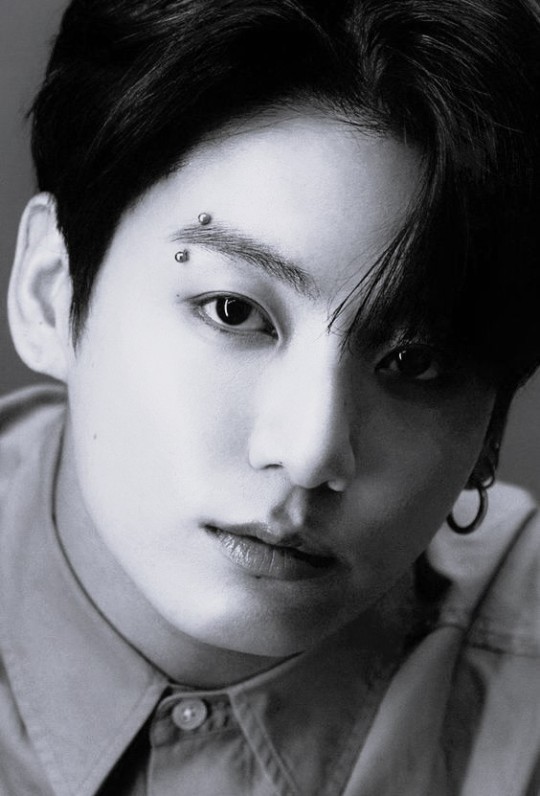
Some fine JK fics for your reading pleasure. 🔞 Please show your appreciation to all the wonderful authors :)
Lone Blue Egg: Jungkook is a simple man. He goes to work, he hangs out with friends, he worries about finding a mate to take home for his hometown breeding season. Maybe he spends a little more money on cam girls than is fiscally responsible but he has niche tastes. Maybe he feels a bit adrift, but he's a young penguin hybrid, supposedly in his prime, far from his crèche. https://archiveofourown.org/works/35424625/chapters/88299640 A Sea Of Indigo: Pitbull Hybrid Jungkook has finally been freed from the fighting rings, and now finds himself at Marigold Sanctuary & Transition Estate, a place for healing and self-discovery for rescued hybrids. It's stupid, dumb, cheesy, and hell-bent on helping Jungkook "heal" and "find himself" and "decide the course of his life." And right at the center of it is Y/N, a nurse who's got everyone bamboozled that she's like some awesome person. She's not that great. Jungkook hates it here. https://archiveofourown.org/works/25881670/chapters/62890984 Sugar Fairy: Bunny Hybrid Jungkook is at that age... he needs a mate, and it's making life miserable for everyone in the family. The obvious solution is to bring home a girl. The obvious problem is that while it's love at first sight for Pippa when he walks into the adoption tent, Jungkook is far more into the sexy cat to her right. Will there ever be peace in the family again? https://archiveofourown.org/works/25882588/chapters/62893486 The Lowlander: Out of the frying pan and into the fire: Marguerite is already used to life as a barely-tolerated outcast, being the elven daughter of an Orlesian noble, but after her travel party is attacked, she goes from one hostage situation to the next. Sure, her new "man" is brave and handsome and one of the best warriors in the Hold, but he's also hard-headed, impatient, and expects her to be the perfect Avvar woman. She refuses. She will not lose herself in this place. Anyway, she only has to endure him until she can figure out how to make her escape, or face an even worse evil at the end of a month... https://archiveofourown.org/works/27747925/chapters/67919119 Meadow: Despite being arranged two decades ago, the start of Bronwen and Jungkook's marriage is a difficult one. Misunderstanding, resentment, and a struggle to control unfamiliar instincts threaten to mire them both in a miserable, unhealthy situation. Before they can even begin to reconcile their new intertwined fate, though, Bronwen begins to suspect there's something else holding them back: a lie that threatens everything she's been raised to believe. https://archiveofourown.org/works/27241096/chapters/66545848 Tell Me What Changed: Alex and Jungkook have been best friends since childhood --actual best friends. She is NOT in love with him, for real, and wishes people would stop assuming that. Why does no one question if he's in love with her? Huh? But it might have to do with his successful fuckboy status, while Alex is very much... not that. Which is fine and doesn't matter! Until Jimin's impending wedding leaves her eager for a date and willing to put herself out there, and Jungkook can't believe what happens next. https://archiveofourown.org/works/38661003/chapters/96652572 Amended: Getting into a bar fight is the least surprising part of Isabella's return home. She sure doesn't expect to run into her childhood friend turned high school enemy, now not just surprisingly a law-abiding citizen but a police officer. Things seem to be going great for him, but Isabella is struggling with more than a bar fight. A single mom with a sick grandmother, an alcoholic mother, an abusive ex, and a short fuse herself, matters are not helped that Jungkook seems to be everywhere. All the time. Especially every time Isabella messes up. Can she really believe him when he says he just wants to help? https://archiveofourown.org/works/27238486/chapters/66539191 Wintervale: Jungkook proves his allegiance to the throne of your kingdom. Fantasy au. https://fantasybangtan.tumblr.com/post/189763429007/wintervale-jjk
#bts jeon jungkook fanfic#jungkook fic recs#jungkook imagines#jungkook smut#jungkook fanfic#jungkook fic#bts jungkook#jungkook#jungkook x reader#jungkook x oc#jungkook x y/n#jungkook x you#bts fanfic#bts jungkook fanfic#bts fic recs#bts smut#bts imagines
70 notes
·
View notes
Text
Codex entry: A Celebration Of Wardens
"Outside times of Blight, Grey Wardens investigate rumors of darkspawn. Ser Kiersten of the Free Marches mounted an expedition to the Frostback Basin to look into one such sighting. She and her fellow Wardens allied themselves with an Avvar hold besieged by darkspawn after an earthquake in the mountains tore open a new passage to the surface. After ten days of fighting, the Wardens and the Avvar drove the darkspawn back and sealed the entrance against further incursions. In celebration of her bravery, the Avvar deployed a feast for Ser Kiersten and her Grey Wardens so legendarily boisterous that there are still paintings and statues dedicated to their alliance littered around the Basin."
—From Journeys of the Wardens: A Comprehensive History by Lady Locke
13 notes
·
View notes
Text
Patterns and Styles: Avvar/Alamarri

Avvar/Alamarri design is quite rustic, stone-based, and sometimes it's hard to differentiate one from another considering their cultural history: the Avvar are a branch of the Alamarri that moved towards the Mountains. Alamarri as well as Avvar and Chasind have a long story of inter-racial mix with the dwarves of Orzammar, which is clear in their art: heavily based on stone and with some imagery of dwarves.
However, it is important to remember that Avvar in particular may have had also relationships with the Elvhenan, as Tyrdda's lover was an elven woman. Their tradition with mages and their treatment of the spirits also resembles their influence from the elvhenan culture. This strange mix is then reflected in the art.
This series of posts are not exhaustive since I’ve developed a very detailed list of tags tracking certain features of a given design. These posts merely try to gather in one place the symbols and elements I used most of the time when identifying buildings in my analysis of DAI.
[This post is part of the series “Patterns and Styles ”] [Index page of Dragon Age Lore]
Patterns
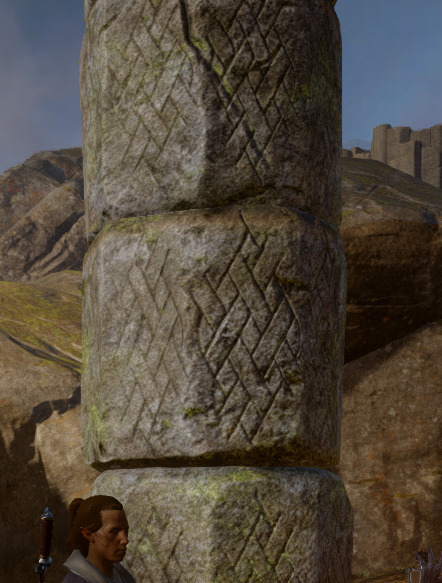
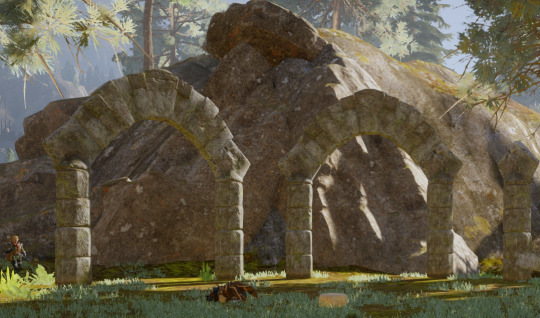
When it comes to patterns, the only one that I can assume is alamarri it's an intricated rhomboid pattern [celtic-like] that we can find in some columns of arches that are spread all over Ferelden. It's not clear for me that this pattern was later imported by the Avvar. However, it's interesting to highlight the resemblance to the elvhenan walls in temples such as in Mythal's Temple [see Patterns and Styles: Elvhenan] which also seems to be related to the pattern found in the pants that Dalish wear, and ironically, Qunari too.
Statues and decorations
1 - Keepers of Fear and their variations
Part of the reason I consider these statues as Keepers of Fear is that they represent similar imagery; they share the style and some characteristics, and are related to the codex The Keepers of Fear. They display the despair and fear that the Alamarri felt when the Blight came from the north. They tend to be elongated humanoids, usually with pointy teeth, without a nose, and screaming/cowering body language.
They also appear close to one another, in groups, in Kenric’s study room in the DLC Jaws of Hakkon [ Frostback Basin [DLC]: Miscellaneous ] implying similar origin for study. They also decorate the paths that head to the Avvar Hold in the DLC, and inside the hold itself.
In the Fade, we find the codex The Keepers of Fear on one of these statues, where we learn that the Alamarri/Avvar used them to scream inside them during the time of the Blight, thinking the darkspawn were spirits. As we know thanks to the DLC Jaws of Hakkon, the Avvar [and by extension most likely the Alamarri and the Chasind] would feed the spirits to keep them close [spirits] or away [demons] from their communities.
1A - Screaming Keeper [Alamarri/Avvar]
Where it can be found:
In Crestwood, in a place a bit isolated closed to a destroyed Andraste statue,
In Fallow Mire: Granite Point [not original from this place],
In Frostback Basin [DLC]: Stone-Bear Hold Avvars : Everywhere, specially along the paths.
In Hinterlands: Minor places, in several places and caves.
In Hinterlands: Redcliffe – Future, along the corridors of the fortress as the Fade and the Waking World get merged.
In the Fade Part 1, Part 2, Part 3, in many places, since this part of the Fade we visit is close to the lair of a Nightmare Demon who feeds upon the Fear and Despair. At some point one of these statues triggers the codex The Keepers of Fear.
The Fade of Flemeth: Part 1, Part 2, as decoration of an avvar/alamarri corridor.

Brief description: This statue is elongated. It has long arms, and its hands are grabbing the face, distorted in fear as it screams. It has no nose. There are some strange appendages falling down and making an extension of its chin [thick beard?]. We can see the ribs very easily, suggesting illness or hunger. It also has elongated legs, one of them crossing over the hip that conveys an impression of more terror and fear.
These Keepers appear quite regularly in all places over Ferelden and the Frostback Mountains. They are inserted in the landscape or along paths, and we can see they are a good reflection of what the codex The Keepers of Fear says: They are part of the Avvar/Alamarri "superstition”: They thought the Darkspawns were bad spirits that fed on fear, so they crafted these statues to feed them far away from their communities, to keep them satisfied and away from them. However, when this did not work [since the darkspawn are not spirits], the Alamarri/Avvar used these statues to scream inside them and pour all their fear into them, “burn” it in order to get rid of it, and go to battle against the darkspawn no matter their gender or age.
In the Frostback Basin [DLC], we can find these statues flanking the path to the Avvar Hold or inside it. In the Fade it makes sense for them to appear where the Lair of the demon Nightmare lives: he has been feeding upon these fears for centuries.
1B - Screaming heads [Avvar]
Where it can be found:
In Frostback Basin [DLC]: Miscellaneous: everywhere
In Hinterlands: Statues, paintings, and structures found in the open , Wolf Hollow, Tyrdda Bright-Axe Path [as a part of the stanza], and Minor places
In Hinterlands: Redcliffe - Future, as the Waking World and the Fade merge one another.
In Therinfal Redoubt [in the part of the Fade]
In the Fade Part 1, Part 3, in many places. This part of the Fade we visit is close to the lair of a Nightmare Demon who feeds on Fear and Despair, so it makes sense we see so many of these Keepers.
The Fade of Flemeth: Part 1, as decoration of an avvar/alamarri corridor.
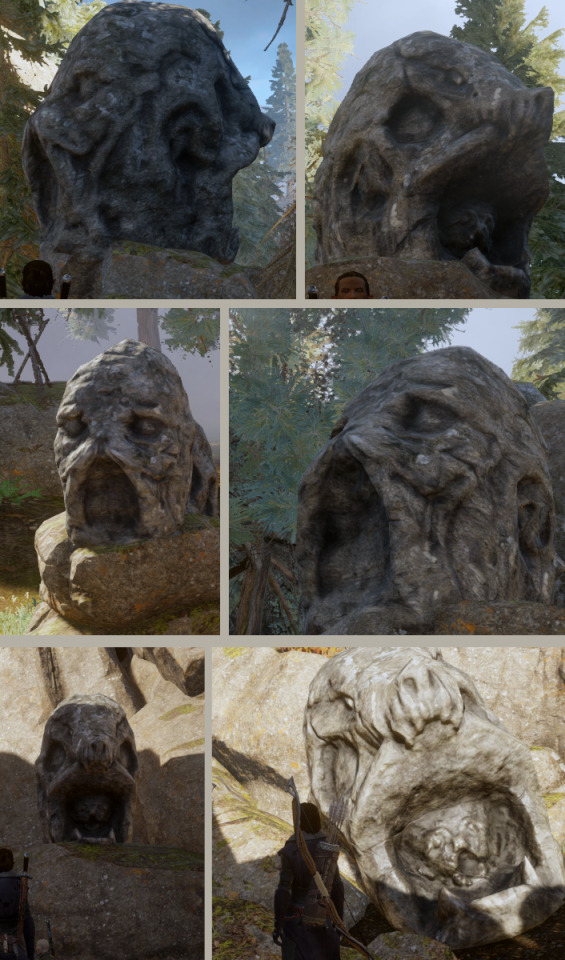
Brief description: This statue is an isolated head with two faces [front and back display different shapes], I can see humanoid faces in them: one as a screaming melted human without nose [which can also be considered the face of a Terror demon or a ghoul], and the other one as a screaming boar of pointy teeth, which inside its mouth there is another screaming face. Everything is too deformed to be precise.

The game efficiently combines these heads in ways that seem to create new different horror statues by clipping them.
We find these faces all over Ferelden and the Frostback Mountains, specially in Avvar/Alamarri territory.
1C - Sitting screaming humanoid [Avvar]
Where it can be found:
In Frostback Basin [DLC]: Stone-Bear Hold Avvars : specially in small cliffs into the sea, where the Avvar can be seen fishing. It can also be found aside a path inside the Avvar Hold.
In the Hinterlands: The Unknown Ruin [Mihris] clipped with a skull.
In the The Fade of Flemeth: Part 2, clipped with a skull.
In Hissing Wastes: scattered objects and ruins, inside a crevice where a Fereldan vendor has been placed, but we only find their mabari and several objects of Ferelden iconography.

Brief description: This statue is elongated and shares many characteristics present in 1A and 1B. It shows long arms, hands covering the eyes, screaming out of fear as it cowers. It's sitting inside a basket. It has no nose and its teeth are pointy. We can see the ribs very easily, suggesting hunger or illness.
During the DLC Frostback Basin [DLC]: Stone-Bear Hold Avvars, Dorian will point out this is an Avvar statue, which makes sense considering we are in an avvar hold.
1D - Sitting screaming humanoid with hands inside the mouth [Avvar]
Where it can be found:
In Razikale’s Reach, as part of the stratification of the Temple when it was taken by the Avvar-Hakkonite and rejected the Tevinters that had been installed around the time of the first Blight.
Inside Skyhold if you pick the Avvar decoration.

Brief description: This statue is elongated and shares many characteristics present in 1A, 1C, 1E and 2. It displays long arms, but no hands. It’s not clear if the hands are inside the mouth or means they were eaten [I favour this second option since these statues tend to be scrawny, conveying the idea of famine, another very common fear among the Avvar, specially during the Blight times]. It has no nose and its teeth are pointy. Its legs are protruding from over the shoulders, giving the sense that this figure is sitting and cowering. We can see a bit of its ribs in between the arms. The position is similar to 1C and 2.
1E - Sitting screaming deepstalker humanoid [Likely Avvar]
Where it can be found:
In Hinterlands: The Unknown Ruin [Mihris] , at the sides of another Avvar/Alamarri statue [1C] clipped with a skull.
In the Fade Part 2 and Part 3, It is a zone where we find a Tevinter sacrificial altar.
In the Fade of Flemeth: Part 1, this statue is beside a sacrificial altar again.
In The Fade of Flemeth: Part 2, it appears at the end, where we find Flemeth. They are positioned as to form a frame for the statue that was stabbed in the back and bleeds.

Brief description: These statues share some similarities with 1A, 1C and 1D: they show long arms, with hands grabbing the sides of the face as it screams. It has no nose nor eyes. We can see the ribs very easily, giving a sense of skeleton [extreme famine?]. What makes this statue particular is the strange mouth, closer in shape to a deepstalker’s mouth. It’s not clear if the figure is sitting, since it has no legs. Its base has the outline of a figure that reinforces the idea of screaming in terror and rising its arms. This figure has a shape that also resembles a terror demon.
In some places in the Fade, the head of this statue is burning, making clear suggestion to the codex of the Keepers of Fear, in particular to the part where they burn their screams of fear to find courage to fight [and die] against the darkspwan.
Rarely appears alone [it’s usually presented in pairs], and when it does, bones and bodies are shown below it, relating it to sacrifices and death. Most likely the concept of sacrifice comes from the part of the codex where once the fears are burnt, the alamarri went to fight a hopeless battle.

What’s interesting of this statue is that it’s a central piece of decoration in the Lair of the Nightmare Demon, in the Fade [check Part 4]. There, we see four of these statues, vomiting blood. Around this spilled blood, some bits of red lyrium can be found. This construction may be entirely done for shock value, since it’s a reuse of several assets assembled in a way that inspire terror and fear just in the moment where the Inquisitor faces the Nightmare demon.
2 - Eroded dragon skull and variations [Avvar]
Where it can be found:
In Swamp Kulsdotten, in the Frostback basin
In Hinterlands: Statues, paintings, and structures found in the open , Wolf Hollow , and Redcliffe – Future.
In the Therinfal Redoubt [As part of the decoration of the fortress’ main room]
In the The Fade of Flemeth: Part 1 as well as the common Raw Fade.
In Hinterlands: The Unknown Ruin [Mihris], as the base of the main, central figure, which is 1C with a clipped skull.

Brief description: I personally call it "Eroded dragon skull", because I have no other way to call it to tag it in the blog. I see a kind of dragon skull with horns that go backwards and then forward, but it also looks like a statue of a humanoid, with elongated legs that protrude from the sides of the skull. Like in the previous statues, it has no nose and seems to have pointy teeth at the end of the “snout”. All the details are blurred for what it looks like erosion.
On its back, this statue has a G symbol which doesn’t present the same level of erosion than the front. I only found a remotely similar symbol in the elven artefact. It’s a strange symbol, dwarven-like even for an “elven” artefact [looks like a squarish swirl]. In fact, that symbol can be found in dwarven objects [specially tapestry and rugs]. Once more, it’s only what I’ve observed, I don’t think we have any evidence to even speculate on this. It looks quite on purpose, though. A whole eroded statue with a clear G on its back is a choice in terms of design.
If we compare this statue with similar ones found in Avvar/Alamarri-related places the common characteristics show up:

It has long limbs, open mouth, and pointy teeth, without a nose. Through these similarities it seems reasonable to relate it with the Avvar culture.
3 - Tyrdda statue [Avvar]
Where it can be found:
In Hinterlands: Tyrdda Bright-Axe Path
and in Hinterlands: inside the Grand Forest Villa.

Tyrdda Bright-Axe was a legendary Alamarri chieftain who is considered the founder of the Avvar.
Brief description: The statue is simple, with a woman holding a sword [which is strange considering the Avvar always knew she was a mage and was holding a staff]. It has limbs a bit elongated and her ribs can be seen.
4 - Lady of the Sky [Avvar]
Where it can be found:
In the Skyhold [Stone-Bear Hold Avvars ] when you pick Avvar Decoration
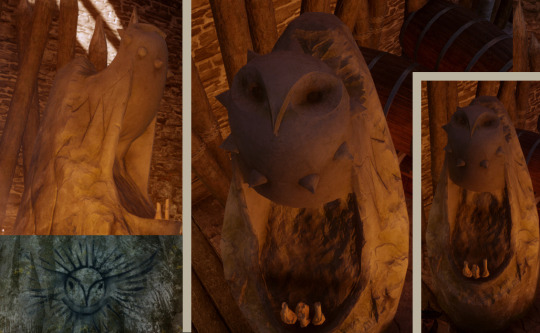
Brief description: This satue is an owl, representation of the Lady of the Skies. I find interesting in her design the ring around her head: small little spikes that may be related or may have inspired artistically other symbols in the game: the thorns that we have seen many times in vines, which have elven influence [after all, the Avvar have a strong elven influence in their culture if we consider the tale of Tyrdda Bright-Axe Path as more or less reliable with respect to her lover of leaf-like ears], or could be an inspiration of a sun. The symbolism of the Lady of the sky with the sun is also shown in her painted representation, as I talked about in the post Dragon Age Iconic Patterns: The Sun.
5 - Korth [Avvar]
Where it can be found:
Stone-Bear Hold Avvars , close to the entrance of the hold,
or in Skyhold when you pick Avvar decoration.

Brief description: This statue shares the similar position of 1C, 1D, and 2, but instead of being a squat position due to fear, in Korth’s case it’s because the weight of the stone. Korth is the Mountain-Father, so this representation shows he is supporting it. His face, so filled with beard, and his body, short and thick, seems to recall dwarven nature, which could exists since the dwarf influence in the Avvar is present in their tales [Trydda had a child with a dwarven prince]. Curiously, it has horns [that can be part of a potential helm he is wearing?]. He is snarling as he endures the weight of the mountain/Stone.
6 - Dwarf with long limbs [Likely Alamarri/Avvar]
Where it can be found:
In Crestwood: surface , Crestwood: Flooded Caves , at the entrance of the drowned village,
In the Stone-Bear Hold Avvars, in the main throne room
In Hinterlands: Statues, paintings, and structures found in the open , Wolf Hollow, and Tyrdda Bright-Axe Path showing the path to some of the statues that trigger Tyrdda’s story.
In an unknown place called the Forgotten Tower, where the presence of this statue seems to reinforce the idea that this place was inhabited by an avvar, as it shows the codex triggered in this place: Old Codex: Mouldy Journal.

Brief description: This statue shares the characteristic of having elongated arms crossed over the chest in similar fashion as some Fereldan drawings seem to have [see Nation Art: Ferelden]. It displays a short man with hair, long beard, and a long, curvy moustache. The back and the front are the same image.
This statue is one of the most reused all over Ferelden, specially in regions where the Avvar-Alamarri presence was strong in the past. I think they represent the dwarves, which makes sense if we read the tale of Tyrdda: Avvar’s chieftains descend from humans and dwarves.
A weak pattern may suggest them as “pointers” or “guides”. Sometimes they are placed in pairs creating a path towards a place of importance [see Tyrdda Bright-Axe Path]. Sometimes, as pointers of graves or special places.
7- Monolith with swirls [Likely Alamarri]
Where it can be found:
In Hinterlands: Statues, paintings, and structures found in the open , Wolf Hollow, Tyrdda Bright-Axe Path
In the Forgotten Tower , where the presence of this statue seems to reinforce the idea that this place was inhabited by an avvar, as it shows the codex triggered in this place: Old Codex: Mouldy Journal.
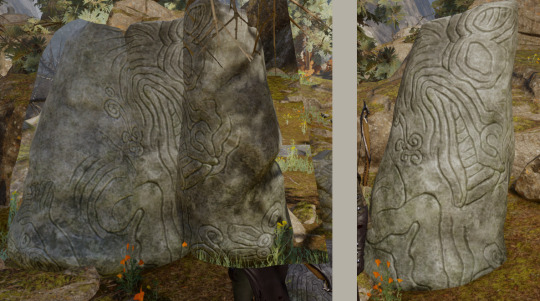
Brief description: I’m not sure if it’s a mabari or a horse. The Avvar are not fond of the mabari, since they are a tamed animal; however, they seem to use an “avvar horse” that looks like a zebra, and it is a bit wild. On the other hand, I also suspect that this statue may be Chasind, simply because in DAO we saw similar monoliths with line patterns on them in the Kocari Wilds [Check Ostagar post or The Blackmarsh and the High Dragon for details]. Unfortunately, these monoliths have no codex associated with them and there is little to speculate about.
8 - Monolith with ropes [Likely Alamarri]
Where it can be found:
In Hinterlands: and Crestwood, but in general all over Ferelden.
In the Frostback Basin and inside the Stone-Bear Hold.

There is no much to say about this element. It appears everywhere, more as a decoration or a support for other statues.
9 - Table of Wolves [Confusing. Likely Ferelden]
Where it can be found:
In Crestwood: surface and Hinterlands: Statues, paintings, and structures found in the open
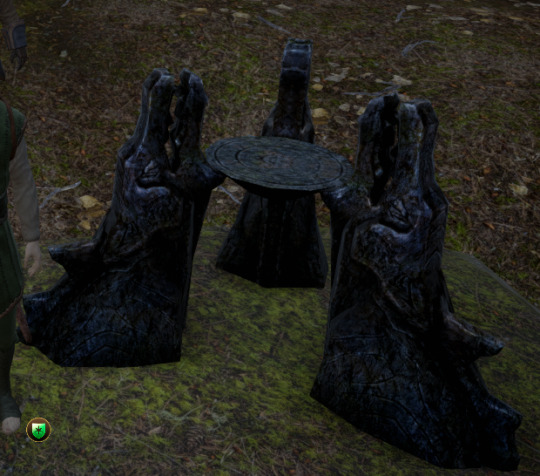
Brief description: a metallic dark table decorated with spiky wolves. The wolves have a strong resemblance to the ones that were painted by Solas in his mural “Inquisition Formation” [Read “The actions of the Inquisitor”]. It seems related to the mabaris/wolves presented in 10A, which tend to appear in Ferelden-based enviroments. It seems to be Ferelden but it could also be inherited through the Alamarri culture. What always caught my attention was the material: unlike the rest of the Alamarri/Avvar statues, it’s not made of stone but dark metal, a Tevinter-origin characteristic.
10 - Mabaris
Mabaris are depicted all over Ferelden without much surprise; Ferelden has a culture deeply entangled with them. However, sometimes the hound silhouette seems to be confused with that one of the wolf and it’s hard to distinguish one from another. We know due to the legends [unreliable sources but decent enough for this level of understanding] that the Alamarri had their dogs. The potential Alamarri origin of the The Ash Warriors [who fight with their mabaris beside them] seem to support those [unreliable] legends. However, the Avvar are not fond of tamed animals, and prefer wild ones that can be befriended, hence why a wolf is more suitable for them. Considering this detail, it’s natural to understand the following statues as somewhat in between the lines of the Culture of the Alamarri, the Avvar, and the Ferelden [maybe even Chasind too?]. The blurred difference between mabari and wolf translates into the difficulty of deciding to which culture these statues belong to.
10A - Pointy Mabaris [Likely Ferelden]
Where it can be found:
In some places in Crestwood: surface
In Therinfal Redoubt as part of the decoration of the Fortress’ main room.
In Frostback Mountains: Haven, as part of the decoration.

Brief description: The look too similar to the wolves drawn by Solas in his mural “Inquisition Formation” [Read “The actions of the Inquisitor”].
10B - Mabaris with lines [Likely Alamarri/Avvar]
Where it can be found:
In Fallow Mire: Granite Point , it is not original from this place, but since it’s kept beside other Avvar statues it may imply same origin too.
In Hinterlands: Wolf Hollow, again found with other Avvar statues.
In Therinfal Redoubt as decoration

Brief description: It is almost a monolith, similar to the ones we find in the Kocari Wilds in DAO [ read Ostagar post or The Blackmarsh and the High Dragon for details] and to 7 but with less curvy lines and more angular ones.
In the Fade Part 3, one of the heads of 1B has this statue sprouting from its mouth, which offers the codex A Plea from the Warrior to the Spirits. It seems to be written by an avvar/alamarri or a descendant of them, for example a Ferelden person who remembers the “old ways”. It speaks about how the wolves had been allies to the humans once, but the softening of the human, the replacement of the hunt as a survival means for an agricultural lifestyle, changed this relationship, replacing the wolf and the hunt, by a hound and a sedentary life. There is a reinforcement of the concept of the wolf as a symbol of freedom and rebellion, as a creature who doesn’t simply obey, like a hound does. Then, the Darkspawn came, putting at risk this comfortable sedentary life, showing how little power hounds have. “Kill the hound in my heart […] in its place, give me the wolf”. The wolf is representation of power, bravery, and freedom, as the mabari represents obedience and loyalty.
10C - Beheaded female Mabari [Likely Ferelden]
Where it can be found:
In Hinterlands: Minor places, specially in a cave where we see several Avvar statues and some Tevinter ones.
In the Forgotten Tower, where the presence of Avvar statues combined with the codex of this place: Old Codex: Mouldy Journal seem to reinforce the idea that this tower was inhabited by an Avvar who was rescued by an Elvhenan.
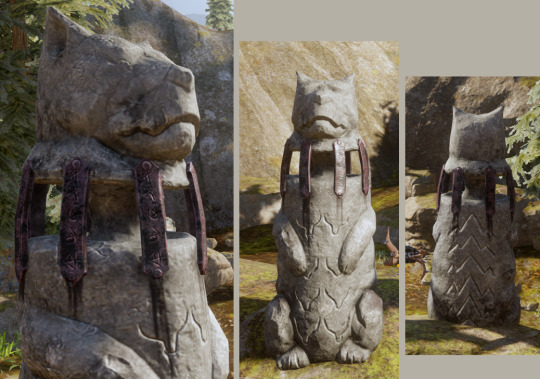
Brief description: It depicts a female mabari which has been feeding puppies [flaccid mammals]. On her back there is a spiky pattern that could be related to the spiky style of the wolves in 9 or 10A. What it’s disturbing is her head, which is barely kept in place because it’s attached with strips that have written runes on them. Inside the space between her head and body, there is usually fire [Waking World] or meat [Fade].
10D - Spiked Mabari [Likely Ferelden]
Where it can be found:
Mostly in Hinterlands: Statues, paintings, and structures found in the open
And in the Seeker fortress during Cassandra’s personal quest.
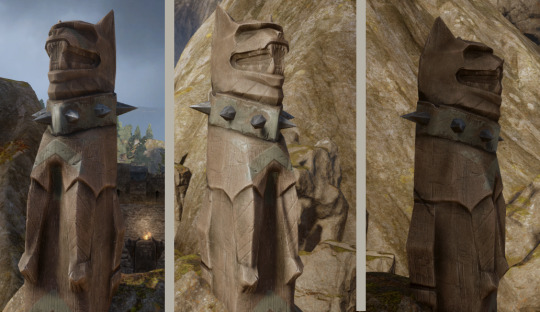
Brief description: These are mabari-totem figures in styles that can be Ferelden most likely, but seem to be inspired in Alamarri/Avvar ones since they have some similarities in style to 10B and 10C. There are no codex associated with them.
11 - Additional elements:
There is an Avvar table used in Stone-Bear Hold Avvars , that was also used to erect the hero of Ferelden’s monument in Hinterlands: Redcliffe - Present , so we can suspect avvar-alamarri-ferelden origin of it.
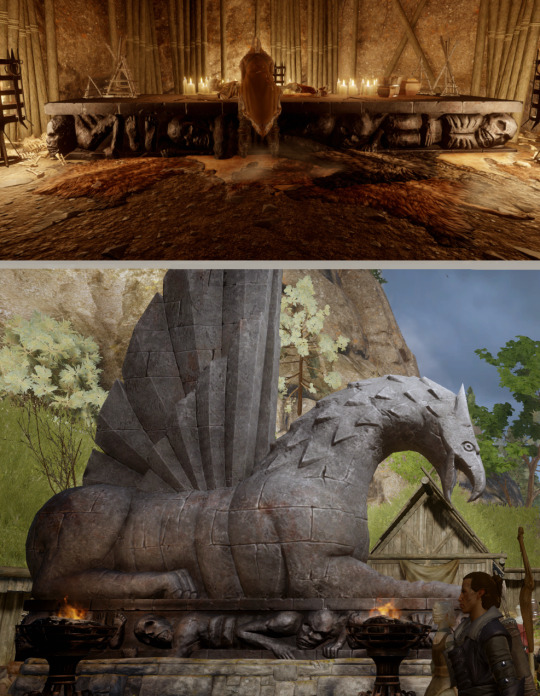
In Skyhold, when we activate the Avvar decoration, we find a unique statue that is not seen anywhere else: it looks like a tree branch-hand holding a bowl. It gives me the impression of a sylvanian hand.
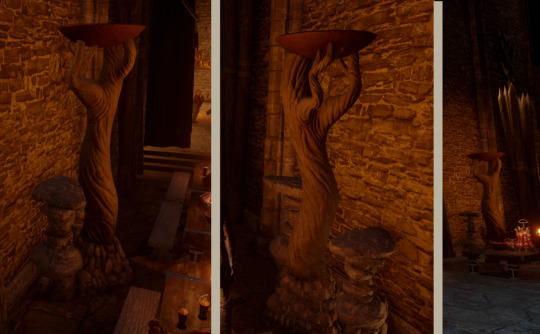
#patterns and styles#pattern design#avvar design#avvar#chasind#alamarri design#alamarri#mabari statues#mabari#lady of the skies#korth
25 notes
·
View notes
Text
this post is under a cut in case anyone would consider it to be DA:D spoilers. (the things it mentions are not new information and it's minor stuff only)
a few weeks ago it was noticed that on this website, a new VA was listed as the voice of several named characters in DA:D - 'Olen', 'Marek’, 'Lord Borgiani’ and 'Templar Captain'. [source] like I said in the tags on that post, I'd guess that these are more minor-type of characters, like sidequest chars or quest-givers, -type of deal. (so this is overanalyzing for sure ik, its just a bit of fun). I was thinking about this again today, wondering what type of characters (e.g. what race, where are they from etc) they are, and also got to looking up the names online. disclaimer: I was just poking around on Google here, if anything here is incorrect or you're familiar with the names/words and know better, pls lmk! ^^
none of the names return any results on the DA Wiki.
Lord Borgiani - Borgiani seems to be a surname that originates in Italy. the nations and groups in Thedas have multiple inspirations/influences from irl (not just the one) ofc. one of these for Antiva is said to be Italy. Borgiani sounds like it could be an Antivan name, so I'm wondering if Lord Borgiani is Antivan. "Lord" implies they are a dude. their Lord status could imply that they're human nobility. Lord/Lady is a noble title in Antiva (not only there though, ofc). thinking of characters like Lord Otranto from Josie's romance and Lord Enzo of Rialto. putting "borgiani" into Google translate, it detects Corsican as the language and advises "bourgeois" in English, which, you could easily make a link from there to a character who has some form of status.
Marek - a "West Slavic (Czech, Polish and Slovak) masculine given name", like "Mark" in English. it's also a surname. allegedly the name means "warlike" or is ultimately derived from Mars, the Roman god of war via, e.g., "Marcus" (name sites are quite unreliable though in terms of the info on them sometimes). Czech, Polish, Slovak, Slavic & so on names in DA World crop up quite a bit as the names of dwarven characters, so I wonder if Marek is a dwarf?
Olen - a given name and a surname. it's also a place in Belgium and Russia, and Olen was a legendary early poet from Lycia. this page gives Olen as being a name related to the name Ole, "a Danish and Norwegian masculine given name, derived from the Old Norse name Óláfr, meaning "ancestor's descendant". this page gives it as the "masculine form of Olena, a name ultimately derived from Ole." hmm, maybe someone Fereldan, Avvar, dwarven or from the Anderfels?
Templar Captain - as a character without a specified given name, surely they are a minor-minor/background character like e.g., "Templar Guard" from Lake Calenhad Docks (DA:O). self-explanatory. likely human.
[context, two]
#dragon age: dreadwolf#dragon age 4#the dread wolf rises#da4#dragon age#bioware#video games#dragon age the veilguard spoilers#<- my da:d spoiler tag just in case#mj meta
39 notes
·
View notes
Text

pirith's fights with @theharellan and @theshirallen are a good excuse to talk about his actual views on the restoration of magic, because in any verse where he's not inquisitor he would be for it.
the problem is that now he's sat behind the desk, he has a different understanding of how the modern the world works. there was never a world where the dalish solution of just wait it out was going to fix anything. he knows that the moment they feel threatened, the people who hold power are going to cut down every man, woman and child of elven blood. magic is a wonderful gift but it can be countered with templars and armies.
they live in a world where the right of annulment exists and orlais can casually burn an entire city to the ground to prove a point, and pirith does not believe magic is the answer to that problem. he thinks it would actually exacerbate it, because if they're treated like this when they're not a threat (specifically to keep them from becoming a threat) how will they behave the moment every elf has the gift again?
and maybe in a world where he's never had to pour over battleplans and direct armies, he would believe that magic is enough to turn the tides. but a newly awakened mage is just as likely to set themselves on fire as they are to burn their target.
pirith wants change. and the way he intends to build change is through skyhold, divine!leliana's reforms, cassandra's reformed seeker order, and eventually, using his status as herald to brute-force reforms in southern thedas while supporting rebellions in the north.
( basically by destabilizing every other government and injecting his own agents into it, but that's a different conversation. )
skyhold is his base of operations and he works with the avvar, the chasind, the mages, the elves, the tal-vashoth, the spirits - all the people that the chantry overlooks or tries to crush. the goal is to make it fully independent and self-sustainable, and i think by the time veilguard rolls around skyhold is understood to be ferelden in name only.
and once veilguard is done, then it is no longer of ferelden and is instead its own independent land.
the problem is, of course, the work is terribly slow and relentlessly soul crushing. he knows eventually it's going to need to turn bloody. he's a painful pragmatist and understands completely that there will be sacrifice and bloodshed, but he's unwilling to pull that trigger until he has enough strength to win.
in some ways he feels like he's not much better than solas as he's aware his people are suffering, that many will die suffering, and that if he were to make bolder moves, he could potentially save them. but he's oh so keenly aware that he's a dalish elf who is balancing on a tightrope, surrounded by hungry and threatened lions who want to tear him limb from limb... and if he acts too fast, too quickly, then someone with more power than him will simply kill them as a show of force.
so the tl;dr is he feels the need to lessen the stranglehold that the current major powers have on elves before the veil falls.
he's not above waging a war with his own armies to make a point, or creating enough unrest and turbulence in these lands to spark a rebellion he'll discreetly arm, but he feels it has to be controlled in order to push things forward. and dropping the veil would lead to too much chaos for his comfort. in his mind, it's more likely that the magisters could use re-immortalized elven blood and make themselves unstoppable.
i think the older pirith gets the more desperate he'll be to ensure things won't backslide the moment he's gone because he knows goddamn well that they will. he's not sure how long he'll live bc the anchor did a number on his physical health - but he's also like, honestly, not really aging that much. but by the point he either drops dead or gets assassinated he truly hopes things will be in a position that someone could drop the veil with significantly less casualties.
3 notes
·
View notes
Text
It didn't allow me to re-read the sign but I swear in Kal-Sharok there's a statue dedicated to paragon wintersbreath?? That's an Avvar name. The dwarves don't have winters. Something is going on here
gaaaahhh I'm so mad how little we got when delving into Kal-Sharok. They just keep repeating "they had to change" but that's what we've been hearing for 4 games w/o an explanation and we still don't know how they became "more like darkspawn" when it should render them sterile
the whole sections is still

4 notes
·
View notes
Text
thinking about jaws of hakkon in particular and how it contains depth and richness and world-building and story and just good fukcing writing that i've only glimpsed dregs of in dav.
the shrine of andraste adorned with halla statues to make it one to ghilan'nain as well, both mortals raised up by the gods. something that would be considered shameful heresy by dragon age-era dalish and andrastians alike but seems to have just been very normal in ameridan's time. this shrine fucked me up so bad i think about it often still, it healed and wounded me at once.
how important it is that some of your companions hate each other - or are at least so ideologically opposed that their only point of connection is the protagonist and they are constantly in simmering conflict with each other.
the avvar being the only sensible people in thedas but still having strong rules about magic and spirit companions, the culture's existence in stark contrast to basically everything else you've seen so far in thedas. they're earthy and grounded and don't really give a fuck about how weird everyone else is but do want to try and trade a bit.
ameridan, the elven mage with dirthamen vallaslin who was best friends with emperor drakon and led the goddamn inquisition, a time before the racism and divisions of dragon age-era thedas, proof that nothing is immutable, things can get worse and therefore they can get better too. ameridan, who was dalish in that he was a citizen of the dales, the elven homeland that to us is a lost tragedy and to him a beloved frustration as he tries to get his fellow elves to work with humans against the second blight instead of coldly watching orlais burn.
solas is there or possibly long gone, but his shadow remains, someone who knows more someone who is outside of all of this someone who is enraged and enchanted and embittered by the way everything has had the nerve to change in ways he did not anticipate or permit. solas the maker who turned away from the world he made but is now back to cast his aloof gaze over all and decide to start again.
in dav I walk through an underwater elven ruin called the ossuary. at first I was excited for some kind of gothic bone palace but there are no bones. it is very unclear what the original purpose of the ruin was, there are no codices for me to find and read, no half-written diaries no poems no manuals no letters no supply lists no descriptions of the wards holding the water back. the wards are failing in places, actually. i watch the water trickle through and wait for one of my companions to comment, even to simply raise the tension by suggesting we need to finish our quest near before the water fails and we're crushed by the sea. i eventually give up waiting. i cannot deduce why this place is called the ossuary - this is not an elven word, and while it has been taken over for some time by the venatori it is a laboratory, not a charnel house. my companions call it a prison, but i can't tell if it was a prison originally built by the elvhen, or only repurposed recently. why is it called the ossuary. i visit the necropolis later, which is full of bones, lots of bones.
it is very beautiful under the sea, but it is also proof that whatever dav is, whatever merits it otherwise has, the levels of history and world-building and depth of lore that were present in the previous games is utterly gone.
#dragon age#dragon age salt#i hate many things about this game#if you love it then that's nice for you#i just needed to get some of my grief out
2 notes
·
View notes